______ DATA
Website Statistics Report 2025
In this website statistics report, we’ve collated the latest web stats and facts for 2025. This includes website traffic statistics (such as the most commonly visited websites), user experience (such as the average time people spend on a website) and B2B ecommerce statistics. We’ve also looked at web design statistics to see the average cost of building a website and the most common CMS systems.
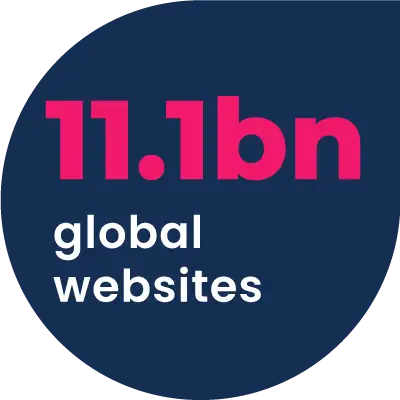

Top 10 Website
Statistics for 2025
There are around 1.13 billion websites globally, with about 350.4 million registered in the U.S. and 11.1 million in the UK.

As of December 2023, Google.com was the most commonly visited website in the world (168.67 billion hits).

More than 9 in 10 (90.68%) global web searches in December 2023 used Google.

More than two-thirds (66.02%) of UK web traffic was from mobile devices, as of December 2023.

It takes the average web user 0.5 seconds to formulate an opinion on a website.

The number of Shopify users increased by 3700% between 2015 and 2024.

The highest average bounce rate of 2023 was linktr.ee (85.56%), with the lowest for pornhub.com (20.80%).

As of 2024, WordPress is the most common CMS, accounting for more than three-fifths (62.9%) of all websites.

More than three-quarters (78%) of UK SMEs have a website.

Amazon.co.uk leads the global ecommerce market, with an annual revenue of over £857 billion.

Global Internet Usage Statistics

At the start of 2024, there were approximately 5.3 billion internet users worldwide, meaning around two-thirds of the population (68%) are connected globally to the World Wide Web.
China has the biggest number of internet users of any country (around 1.05 billion), accounting for almost a fifth (19.8%) of the global internet population.
The region with the world’s highest internet penetration rate is Northern Europe, where around 97 out of every 100 people (97.3%) are connected to the Internet.
Global Website Traffic Statistics
How many websites are there in the world?
How many websites are there in the world? It’s estimated that there are more than 1.1 billion websites in the world. Around 201 million of these are active, accounting for less than a fifth (18%) of the overall total.
Since 2013, the number of websites around the world has almost doubled from around 630 million to 1.13 billion.
By 2017, the number of global websites had trebled to 1.8 billion in just 4 years, reaching a peak of 1.8 billion the following year. Since then, the figure has dropped by almost two-fifths (37.57%).
The number of active websites globally during this time has fluctuated from a peak of 202.9 million in 2023, down to a low of 170.26 million in 2016.
Number of websites in the world by year
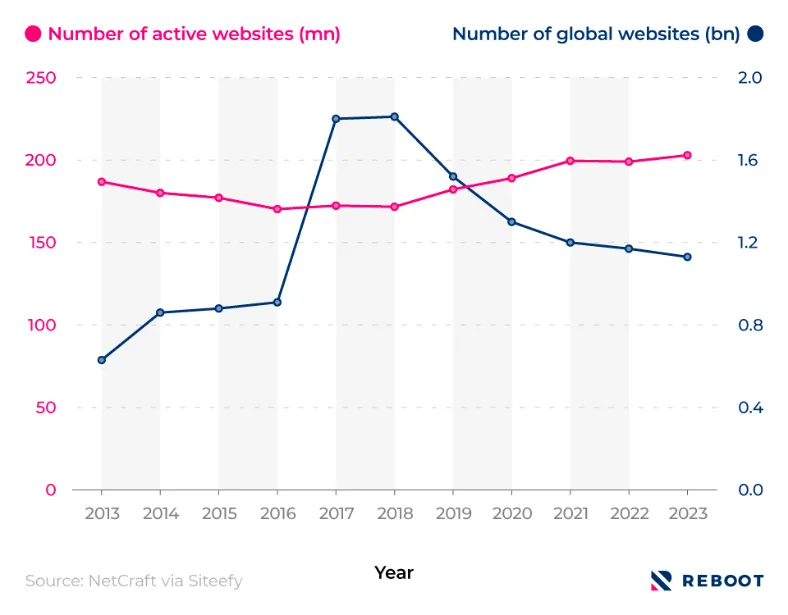
The .com domain dominates the top-level domain (TLD) market, with almost 9 times more in existence than .cn of China in second position (18 million) and .de of Germany in third (17.4 million).
Top-level domain (TDL) statistics by the number of registered domains
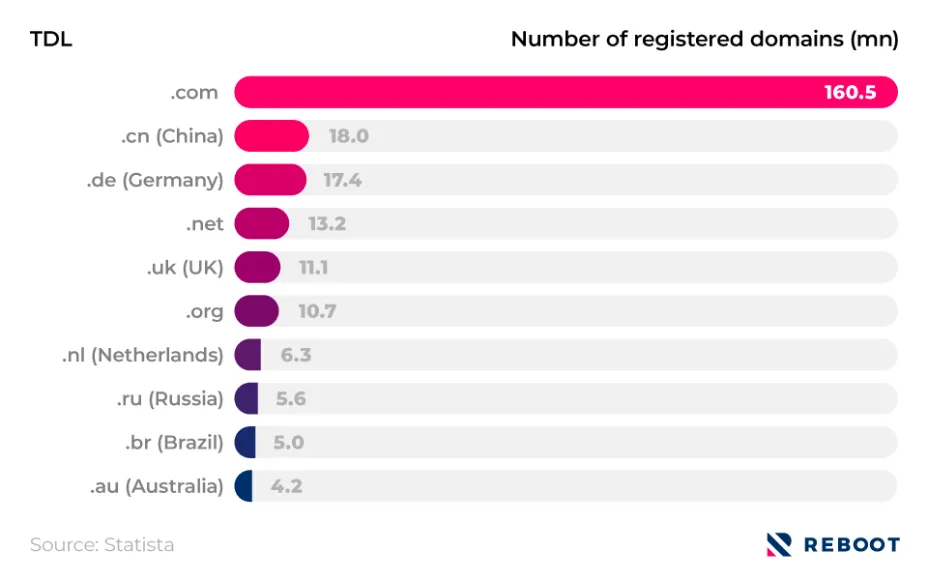
Statistics on the world's most popular websites
Most visited websites in the world
Website visitor statistics from Semrush show that, as of December 2023, google.com was the most commonly visited website in the world (168.67 billion visits).
The vast majority (83.64%) of people use their mobile during this time to visit the site, accounting for more than 141 billion visits worldwide.
Most visited websites in the world (December 2023)
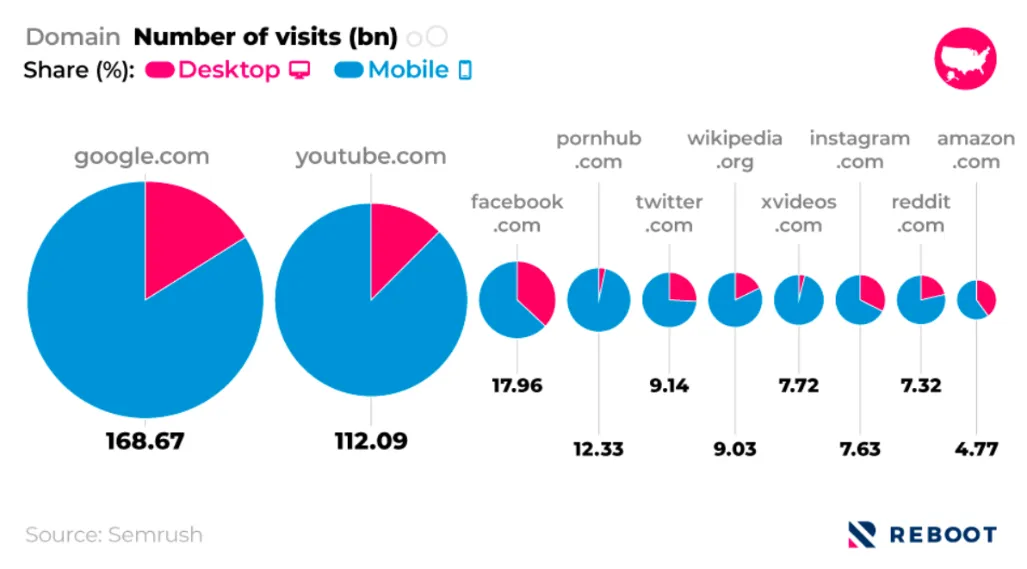
Google.com was searched 56.58 million times more in December 2023 than youtube.com in second place, with 87.35% opting for their mobiles over desktops to do so.
In terms of website traffic statistics, google.com remained the world’s most commonly visited website throughout 2023, fluctuating between 40.49 billion visits in January and 34.25 billion in August — a difference of around 6.25 billion in 8 months.
Youtube.com visitor statistics during the same period followed a similar pattern, rising by 2.94 billion between March and August 2023.
Of the top 10 most visited websites in the world in 2023, most experienced their lowest visitor numbers in August, with an average of 32.62 billion across all 10 sites. This is contrasted by the highest visitor figures coming in either January or March, with averages of 37.39 billion and 38.31 billion, respectively.
World’s most commonly visited websites over time
Since 2017, there has been very little change at the top of the world’s most popular websites. As of January 2017, YouTube was the world’s most commonly visited website, with around 18.9 million views (0.6 million more than Google for the same month).
By November 2017, this gap had widened to almost 3.5 million in favour of YouTube, when it’s monthly visit numbers increased to 18.8 million and Google’s dropped to around 15.3 million.
However, from December 2017, YouTube and Google had swapped places, with the latter’s monthly visits rising to 20.3 million by the end of 2017. YouTube, by contrast, dropped to second with 19.6 million.
By August 2021, YouTube’s monthly visitor numbers had regained ground on Google, surpassing 70 million monthly views for the first time ever. This caused it to overtake Google by almost 1.5 million for the month – a potential side effect of the Covid pandemic with more people at home watching videos online.
This was relatively short-lived, as by April 2022, Google regained top spot, with YouTube’s numbers dropping to around 56.3 million vs Google’s 68.9 million.
Most popular types of websites in the world
Most popular types of websites in the world Our statistics on the world’s most visited websites also highlights how the popularity of certain websites has changed over time.
In January 2017, the 10 most popular websites in the world were fairly evenly split between news, entertainment, and service (YouTube, Wikipedia, and Amazon), search engines (Google, Yahoo, and Yandex), and social media (Facebook, VK, and Live.com).
The following year saw the rise in further social media websites, such as Twitter (now X) and Instagram, to become the seventh and ninth most popular websites in the world by August 2018 (3.8 million vs 3.1 million monthly visits, respectively).
By January 2019, adult entertainment services began to dominate the world’s most popular websites list, with Xvideos (sixth), XNXX (seventh), and PornHub (ninth) all creeping into the top 10 most visited websites for the month. In January 2019 alone, there were more than 10 million monthly visits to these 3 websites combined – around 3 million more than Wikipedia for the month, yet approximately half the number visiting Facebook.

By 2020, Google was now dominating the top 10 search engines, with Yahoo dropping out of the list by June. By this stage, around 25 times more people were using Google than Yahoo (75.14 million vs 3.06 million, May 2020).
Despite a brief spell in second spot in between May and October 2020, Facebook has remained the third most visited website in the world ever since, with Instagram and Twitter fluctuating anywhere between fifth and tenth spot.
In November 2021, Reddit made it’s first appearance in the world’s 10 most visited websites, with around 5.2 million views. By December 2023, it’s average monthly viewership had risen by almost 2 million, yet it’s relative global popularity remained ninth.
World’s most visited websites on desktops over time
Google.com continued to be the world’s most commonly visited website from desktop devices throughout 2023, with the first half of the year generally receiving higher visitor numbers compared to the second half of 2023. This ranged from a peak of 33.04 billion in March 2023, down to a low of almost 26.21 billion in August — a difference of around 6.83 billion.
Youtube.com was the second most visited website globally from desktop devices in 2023, registering its highest visitor numbers in March (15.76 billion). This dropped to 13.69 billion in August 2023, representing a drop of around 2.07 billion visits across 5 months.
Since 2018, Google has dominated the list of most popular websites in the world, with 38 million more monthly views than second-placed Facebook as of January 2020 (46.45 million vs 7.68 million, respectively). At this point, YouTube had less half the number of monthly views (3.2 million) in comparison to Facebook, putting it in fifth and 1.8 million behind Wikipedia.

However, by April 2021, the number of monthly visits to YouTube from desktops ballooned, increasing by almost 100% from March alone to nearly 70 million. July 2021 saw searches for YouTube overtake that of Google on desktops for the first time ever (56.45 million vs 49.45 million, respectively), with the gap increasing to almost 22.8 million by January 2022 in favour of YouTube. Normality was restored by April 2022, when Google reclaimed the top spot after average monthly visitor numbers to YouTube dropped to 36.45 million.
Between 2018-23, the 10 most popular types of websites in the world on desktop devices have tended to be social media apps or adult entertainment sites. Yet, the top 3 have generally been contested by the search engines (such as Google) and news, entertainment, and services (such as YouTube and Wikipedia).
The exception to this is Facebook, which held onto second position for most of 2018-20. Adult entertainment websites (such as PornHub and Xvideos) started to break into the world’s top 5 most visited websites around mid-2022, yet fell out of popularity in 2023 to be replaced by a series of news, entertainment, and service-based websites, such as Amazon, WhatsApp, and MicrosoftOnline.
World’s most commonly visited websites on mobile devices over time
Google.com was the most commonly visited website on global mobile devices throughout 2023. In March 2023, it was viewed around 152.80 billion times by mobiles around the world — the highest recorded figure of the year — before dropping to a low of 128.27 billion in August. This represented a decrease of almost 24.53 billion in just 5 months.
Youtube.com (the second most commonly visited website from global mobiles in 2023) saw a difference of 13.71 between its peak visitor numbers in November (103.25 billion) and the lowest recorded figure for the year in August (89.54 billion).
Between January 2018 and June 2021, Google’s average number of monthly visitors increased by almost five times the amount from 23.4 billion to 119.1 billion. July saw Google’s monthly visitor numbers decrease by more than a half to make YouTube the most commonly visited website in the world from mobile devices – a title it would retain until April 2022 when Google’s figures restored themselves to overtake YouTube once again.
By January 2023, around 50 million more people per month were accessing Google from their phone compared to YouTube (145.7 billion vs 94.7 billion, respectively).
Global Website search statistics
How much global website traffic comes from search engines?
As of 2023, around 9 in 10 (90.68%) global searches took place using the Google search engine.
Bing and Yahoo had a similar market share percentage in 2023, collectively accounting for 6.4% of the search engine market.
Global website search statistics by search engine
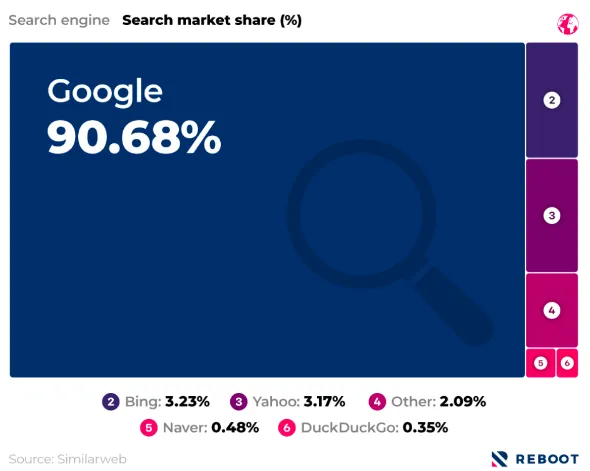
Global percentage share of web traffic over time
Between 2009 and 2023, Google has generally dominated the global search engine market, fluctuating somewhere between 90% and 93% during this period. 2019 saw the peak percentage share of global web traffic, when it reached 92.63%.
Average global web traffic over time by search engine
By 2023, almost three times less web traffic was coming through Yahoo compared to 2009, when its average percentage share dropped to 1.16%.
Bing’s relative popularity doubled between 2009 and 2014, when it reached 3.64%. However, has since been on a steady decline, reaching just under 3% by 2023.
Global percentage share of web traffic by device over time
As of December 2023, two-thirds (66.02%) of global web traffic was from mobile devices. Less than a third (32.54%) was from desktops, with the remaining (1.44%) from tablets.
Global website search statistics by search engine across desktop devices
As of December 2023, Google accounted for the majority of web traffic from global desktop devices (81.71%). This was around 8 times more than Bing, which was responsible for around 1 in 10 (10.53%) web searches across the globe.
Global web traffic from Google on desktops reached a peak of 87.65% in May 2023 — a +5.94% difference from December figures. During a similar period, Bing’s popularity rose by +3.48% between April and December 2023 — the first time in 2023 that global web traffic from peak exceeded 10%.
Google’s dominance in the world of web traffic has gradually decreased since 2009, when around its percentage share of global web traffic stood at around 90.1%. By 2023, this had fallen by almost 5.7%.
Over the same period, Bing’s percentage share of global web traffic increased four-fold, from 1.9% to around 8.7%.
Global website search statistics by search engine across mobile devices
Google dominated global web traffic statistics for mobile devices in December 2023 (95.48%). Yandex had around a third more web traffic from mobiles compared to Baidu, although collectively this accounted for just 2.41% of the overall total monthly figures.
The percentage of global Google searches from mobiles peaked at 96.63% in March 2023 — around 120 times more searches than Yandex (the second most popular for the month).
Over time, Google has steadily remained the most popular search engine globally across all mobile devices. However, from a peak of 97.99% in 2009, its percentage share of web traffic has declined since, reaching a low of 93.83% in 2014. As of 2023, this figure stood at an average of 93.93% for all web traffic via mobiles.
Despite a peak of 3.65% in 2014, Yahoo’s share of web traffic from mobiles declined between 2009-23, falling from 2.73% to 0.57%, respectively.
Want a tailored statistics page that drives authoritative links and boosts your site’s SEO? We specialise in data-driven content assets that attract organic traffic and elevate your site’s authority.
Reach out to find out how we can work together.
Global Website
UX Statistics
What is the average time spent on a website?
Our analysis shows that the average time spent on a website (i.e. average visit duration) for the top 100 most commonly visited websites of 2023 was 15 minutes and 19 seconds.
According to consumer research, people typically only read just over a quarter (28%) of words on a website. Therefore content structuring is critical if you are to keep visitors engaged and on your website for longer.
Of the world’s 10 most commonly visited websites in 2023, the average time spent by visitors was 18 minutes and 22 seconds.

Average time spent on a website for the world’s most visited websites of 2023
on website
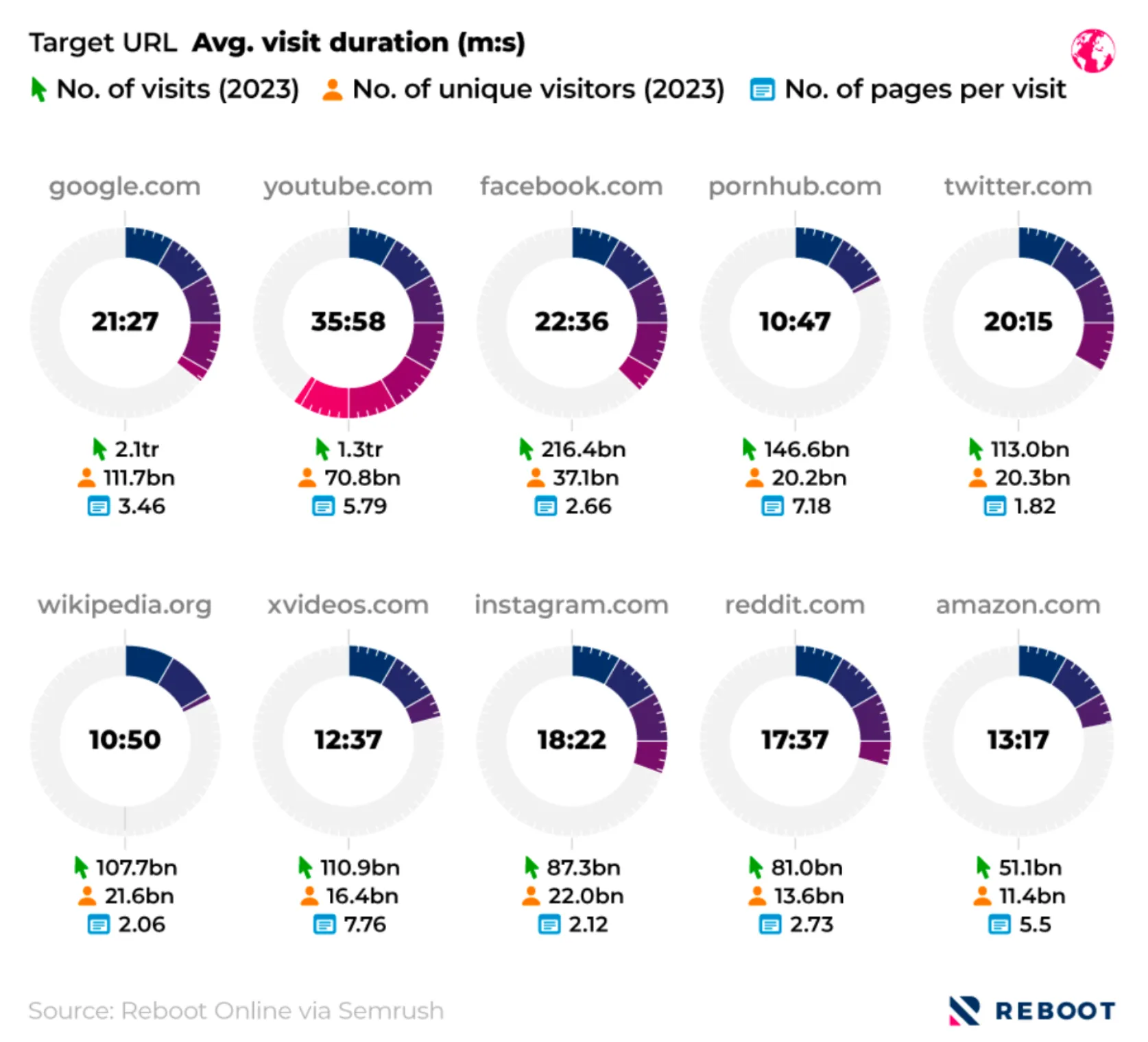
On average, global website visitors spent the longest on youtube.com (35 mins and 58 seconds) — almost 14 minutes longer than the typical Google visitor in 2023.
Conversely, the average visitor to pornhub.com and wikipedia.org spent just under 11 minutes on each site, around half the amount of time for respective visitors of twitter.com.
Users of xvideos.com and pornhub.com typically visited more than 7 pages per visit in 2023, compared to just over 2 pages per visit for those using twitter.com.
Longest average time spent on a website in 2023
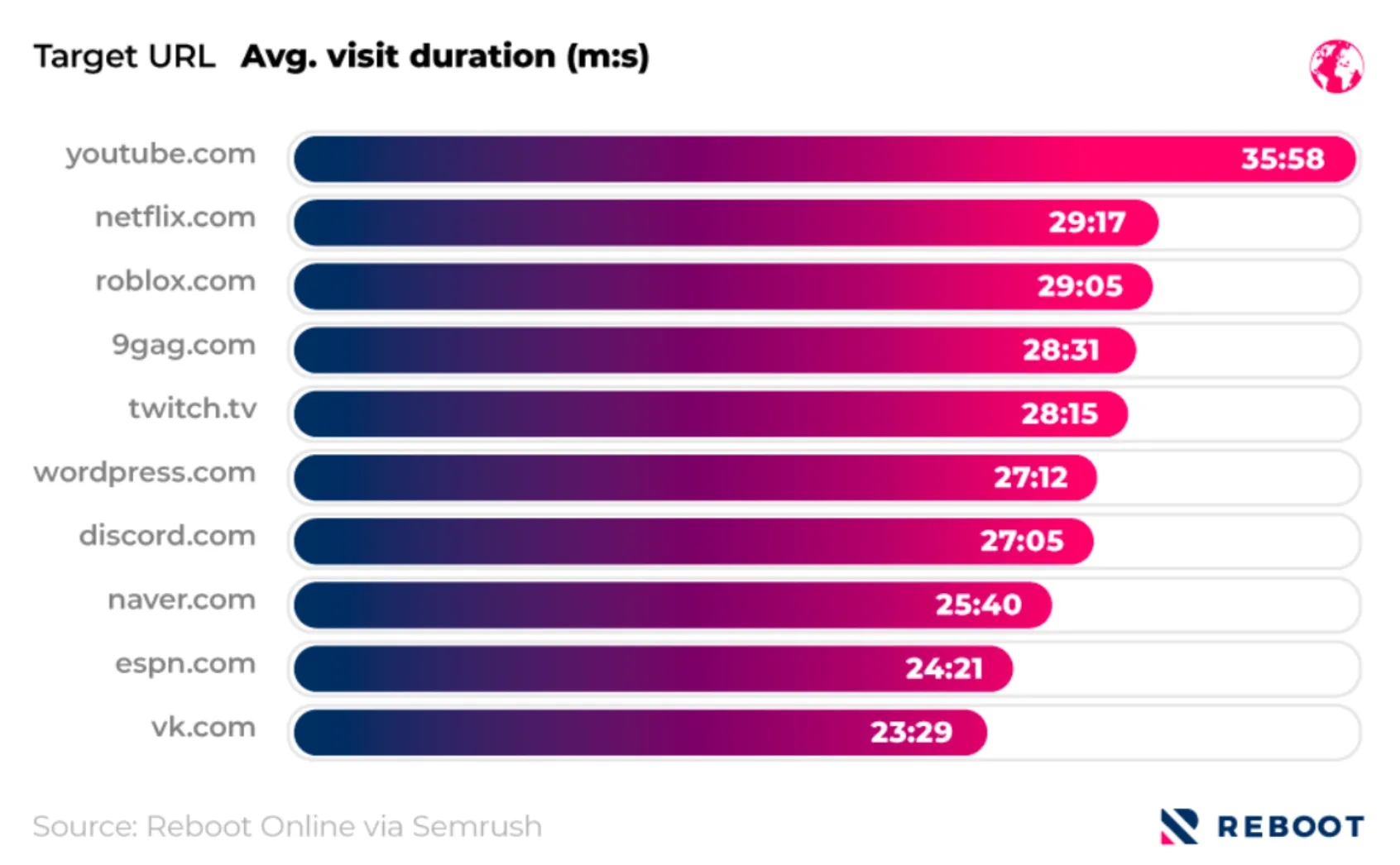
time on website
= YouTube
Global internet users spent longer on youtube.com than any other of the world’s 100 most visited websites in 2023, with a typical visit duration of 35 minutes and 58 seconds. This was around 7 minutes longer, on average, compared to netflix.com and roblox.com in second and third, respectively.
In terms of the average number of pages viewed per visit, a typical youtube.com user in 2023 visited between 5 and 6 pages when accessing the site. This is almost a page per visit less than a typical roblox.com visitor, but around 5 times more than the average visitor of 9gag.com in fourth.
Shortest average time spent on a website in 2023
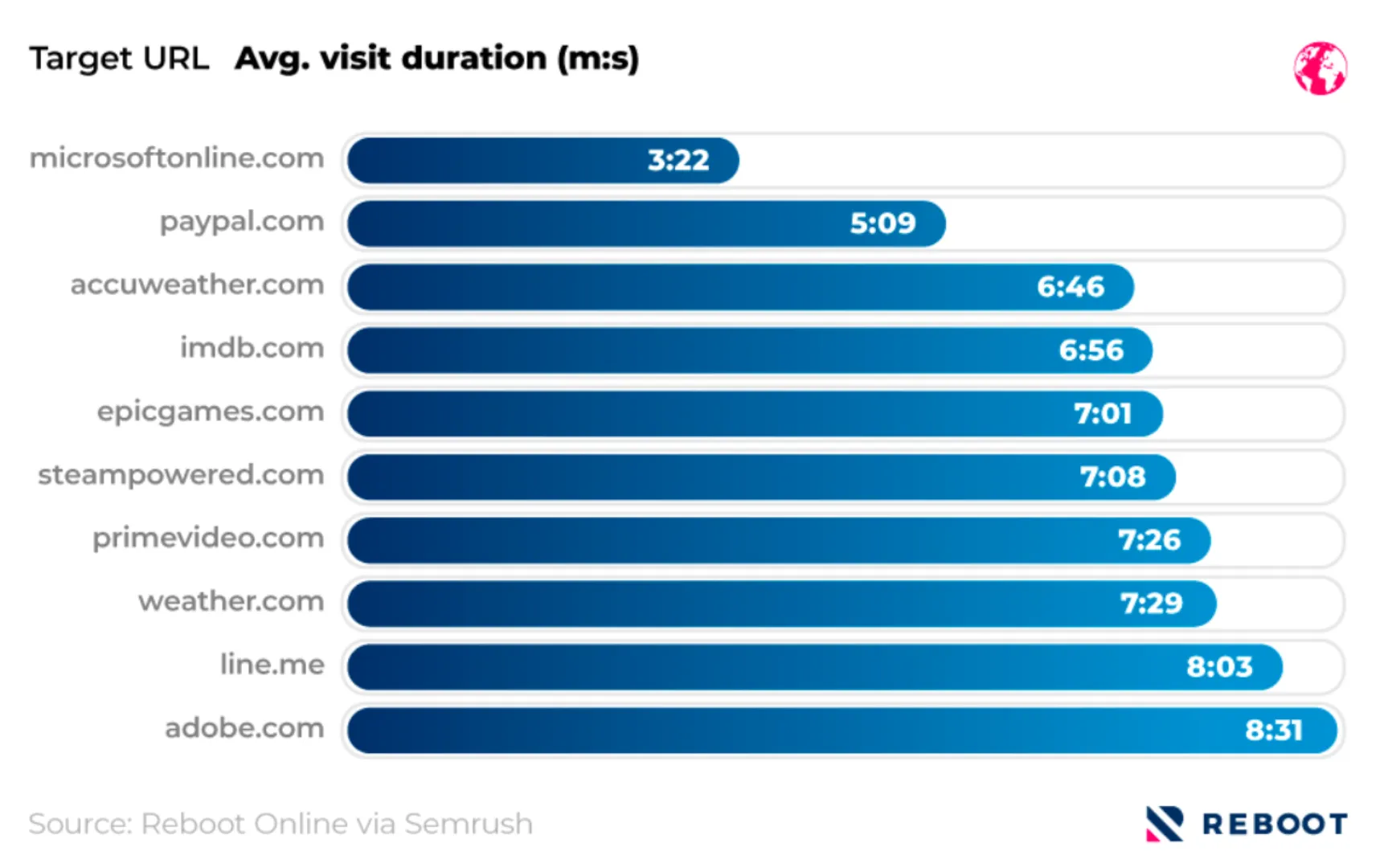
Our analysis of the shortest average time spent the world’s 100 most visited websites reveals that the least amount of time was typically spent for those who visited microsoftonline.com. Internet users in 2023 typically spent 3 minutes 22 seconds visiting the site.
This was around 2 minutes less than typical visitors to paypal.com in second, and around half the amount of time for the average visitor to accuweather.com in third.
Users of paypal.com would typically click on 3-4 pages when visiting the site — more than double the amount of weather.com and line.me in eighth and ninth, respectively.
Global average website bounce rate statistics
What is the average bounce rate of a website?
The average website bounce rate for the world’s top 10 most visited websites of 2023 stood at 48.24%.
Average bounce rate statistics for the world’s most visited websites of 2023
Of the world’s 10 most visited websites in 2023, twitter.com had the highest average bounce rate at 72.08%. This was almost 3.5 times greater than the average bounce rate for pornhub.com — the lowest bounce rate from the list.
Highest average bounce rate statistics for the world’s most visited websites of 2023
Note: ‘Twitter.com’ became ‘x.com’ in July 2023 hence why both appear in the data, even though they are technically the same website.
Of the world’s 100 most visited websites of 2023, linktr.ee had the highest average bounce rate at 85.56% — around 3.5% greater than x.com in second place.
Our website analysis highlights that websites with a higher bounce rate typically tend to have a lower average number of pages per visit. For example, global visitors to linktr.ee viewed 1.29 pages per visit in 2023 — as opposed to 1.82 for twitter.com, which had a bounce rate that was around 13.5% better by comparison.
Lowest average bounce rate statistics for the world’s most visited websites of 2023
In terms of lowest average bounce rate statistics globally, pornhub.com came out top in 2023 from the world’s 100 most visited websites. At just 20.8%, this represented a bounce rate marginally better than xvideos.com in second (21.68%), yet was almost 14% better than youtube.com in tenth.
Overall, pornhub.com’s average bounce rate in 2023 was more than 4 times better than linktr.ee.
This analysis supports the theory of an inverse relationship between bounce rate and the average number of pages per visit. The 3 websites with the lowest bounce rate typically registered between 7-8 pages per visit in 2023, contrasted by those with the highest bounce rate that typically generate 1-2 pages per visit.
Highest average website bounce rate statistics between global desktop and mobile devices
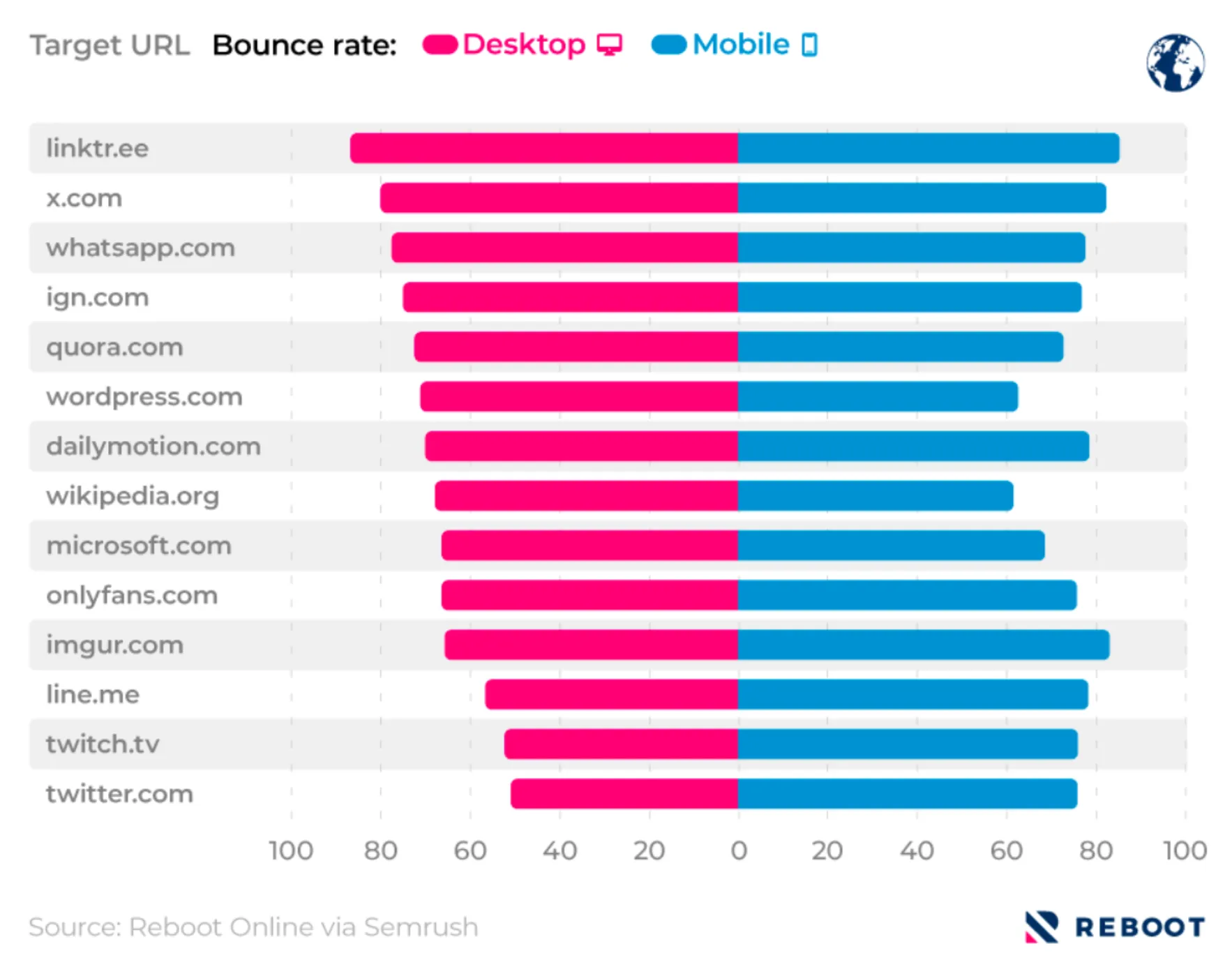
The highest average bounce rate in 2023 across desktops was registered for linktr.ee (86.81%%) — around 1.6% higher compared to mobile devices. Yes, this figure of 85.22% was also the highest recorded average bounce rate for mobiles in 2023.
The largest difference between average bounce rate statistics for global desktops and mobiles in 2023 was twitter.com (typically around 25% lower for desktops by comparison). Conversely, the smallest gap in average bounce rate statistics was found to be whatsapp.com (just 0.03% in favour of mobiles).
Lowest average website bounce rate statistics between global desktop and mobile devices
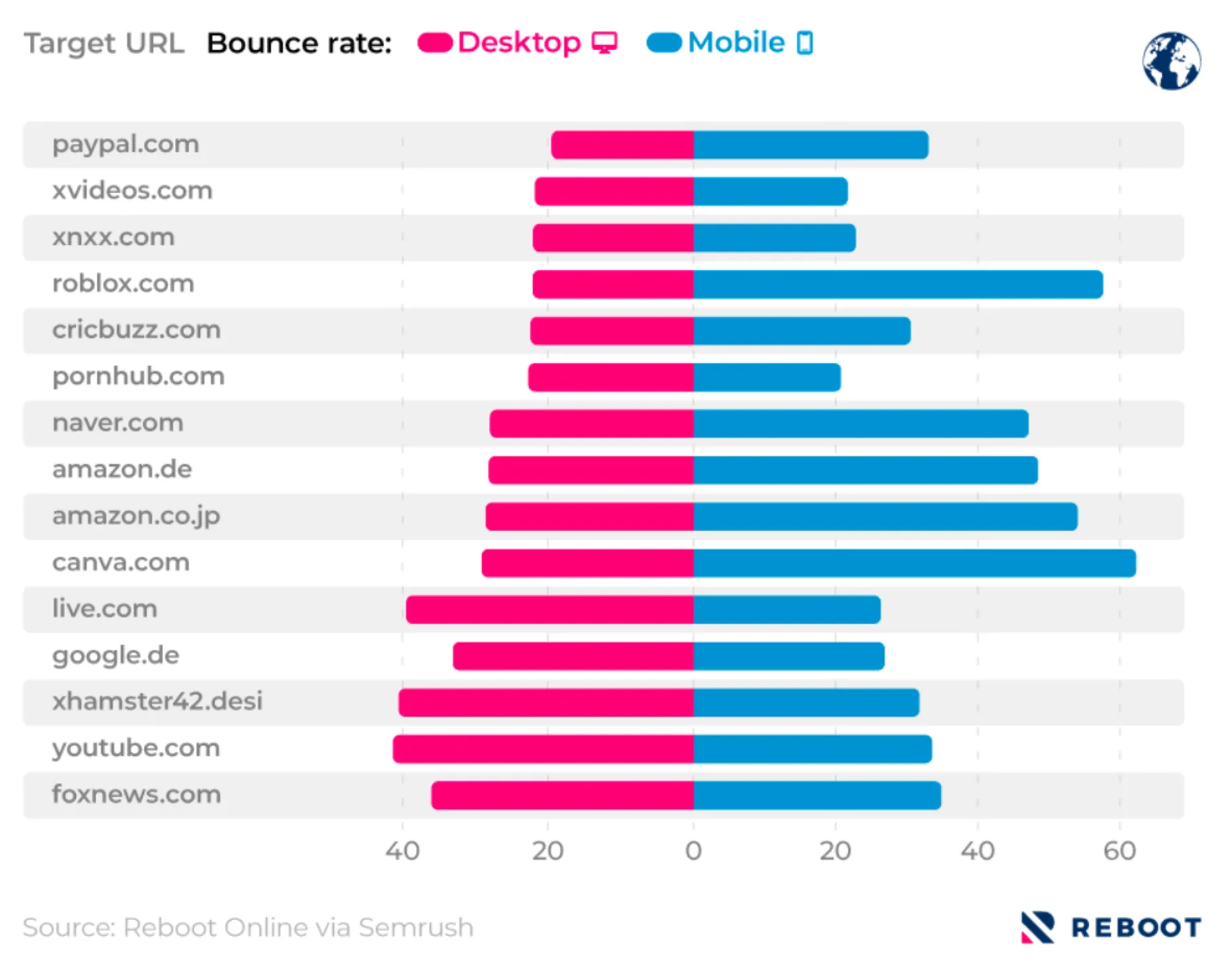
The lowest global average bounce rate across websites in 2023 is awarded to paypal.com for desktops (19.5%) and pornhub.com for mobile (21.67%).
Globally, the largest difference in average bounce rates between desktop and mobile devices in 2023 was canva.com.
On the other hand, the smallest gap in average bounce rate statistics between global devices was xvideos.com (0.13% in favour of mobiles).
Average website load time statistics
What is the average load time for a website?
Website load speed statistics suggest that just a 1 second delay in a website’s loading speed could reduce the number of page views by as much as 11% and customer satisfaction by up to 16%. Research also reveals that almost half (47%) of people give up on a website that takes more than 2 seconds to load.
With that in mind, we decided to analyse website load speed statistics for the 100 most visited websites of 2023 to see which had the fastest website load speed and how they compared to one another.
Fastest average website load speed statistics for the world’s most visited websites of 2023
| Site | First Contentful Paint Value (seconds) | Time To Interactive Value (seconds) | Server Response Time Value (seconds) | Largest Contentful Paint Value (seconds) | Network Server Latency Value (seconds) | Speed Index Value (seconds) | Speed Index Score |
|---|---|---|---|---|---|---|---|
| google.com | 0.69 | 1.30 | 0.11 | 1.11 | 0.00 | 0.77 | 0.99 |
| yandex.com | 0.90 | 0.90 | 0.10 | 0.93 | 0.07 | 0.90 | 0.98 |
| xnxx.com | 0.93 | 2.09 | 0.11 | 1.36 | 0.11 | 0.93 | 0.98 |
| ozon.ru | 0.78 | 2.24 | 0.09 | 1.42 | 0.13 | 0.98 | 0.97 |
| discord.com | 0.76 | 3.44 | 0.03 | 0.96 | 0.03 | 1.01 | 0.97 |
| indeed.com | 0.90 | 2.85 | 0.16 | 0.90 | 0.17 | 1.04 | 0.96 |
| canva.com | 0.97 | 2.91 | 0.18 | 1.02 | 0.25 | 1.12 | 0.95 |
| openai.com | 1.17 | 1.58 | 0.03 | 1.37 | 0.06 | 1.17 | 0.93 |
| mega.nz | 1.21 | 1.21 | 0.00 | 1.21 | 0.02 | 1.21 | 0.93 |
| apple.com | 1.17 | 1.76 | 0.11 | 1.90 | 0.04 | 1.32 | 0.89 |
(Source: Reboot Online via Google Lighthouse API)
The Speed Index Score is generated by Google
Lighthouse API using several variables, including:
-
First Contentful Paint - the time at which the first text or image is painted
-
Time To Interactive - how long it takes for the page to become fully interactive
-
Server Response Time - the time it takes between a client requesting a page in a browser and a server responding to that request
-
Largest Contentful Paint - the time at which the largest text or image is painted
-
Network Server Latency - the time it takes for data to transfer across the network (i.e. the relative delay in communication)
-
Speed Index Value - how quickly the contents of a page are visibly populated.
According to an analysis by SEO agency Reboot Online, google.com had the highest speed index score of the 100 most visited websites in 2023, at 0.99. Google.com’s average website load speed of 0.77 seconds made it the UK’s fastest loading website of 2023 — around twice as quick as apple.com in tenth position (1.32 seconds).
Slowest average website load speed statistics for the world’s most visited websites of 2023
| Site | First Contentful Paint Value (seconds) | Time To Interactive Value (seconds) | Server Response Time Value (seconds) | Largest Contentful Paint Value (seconds) | Network Server Latency Value (seconds) | Speed Index Value (seconds) | Speed Index Score |
|---|---|---|---|---|---|---|---|
| aliexpress.com | 2.6 | 9.76 | 0.49 | 8.58 | 0.49 | 6.51 | 0 |
| ebay.com | 2.88 | 5.9 | 0.3 | 3.32 | 0.29 | 6.55 | 0 |
| microsoft.com | 2.12 | 6.95 | 0.75 | 4.57 | 0.29 | 7.11 | 0 |
| tiktok.com | 1.76 | 7.88 | 0.33 | 5.52 | 0.55 | 7.25 | 0 |
| nytimes.com | 1.31 | 10.25 | 0.01 | 1.68 | 0.31 | 7.41 | 0 |
| rakuten.co.jp | 3.1 | 12.31 | 0.46 | 7.51 | 0.91 | 8.56 | 0 |
| dailymail.co.uk | 2.1 | 12.61 | 0.42 | 4.2 | 0.45 | 9.01 | 0 |
| shopee.co.id | 3.48 | 9.29 | 0.61 | 7.24 | 0.3 | 9.75 | 0 |
| dcinside.com | 7.61 | 10.92 | 0.31 | 8.51 | 0.32 | 10.93 | 0 |
| livedoor.com | 4.78 | 4.78 | 0.24 | 4.78 | 0.45 | 5.95 | 0.01 |
In terms of the slowest average website load speed for 2023, that crown goes to dcinside.com, with a typical load speed of 10.93 seconds.
Of the top 10 most commonly visited websites of 2023, very few websites could compete with google.com in first position (typical 0.77 seconds loading speed).
In all, when comparing the fastest and slowest websites of 2023, google.com’s average load speed was more than 14 times faster than dcinside.com by comparison.
Average website load speed statistics for the world’s most visited websites of 2023
| Site | First Contentful Paint Value (seconds) | Time To Interactive Value (seconds) | Server Response Time Value (seconds) | Largest Contentful Paint Value (seconds) | Network Server Latency Value (seconds) | Speed Index Value (seconds) | Speed Index Score |
|---|---|---|---|---|---|---|---|
| google.com | 0.69 | 1.3 | 0.11 | 1.11 | 0 | 0.77 | 0.99 |
| youtube.com | 1.24 | 5.89 | 0.07 | 3.55 | 0.12 | 3.97 | 0.1 |
| facebook.com | 1.44 | 1.44 | 0.21 | 1.49 | 0.13 | 1.44 | 0.85 |
| pornhub.com | 1.87 | 3 | 0.14 | 2.61 | 0.1 | 1.87 | 0.68 |
| xvideos.com | 1.21 | 3.24 | 0.16 | 1.88 | 0.16 | 1.4 | 0.87 |
| twitter.com | 0.58 | 2.99 | 0.14 | 2.7 | 0.19 | 2.72 | 0.35 |
| wikipedia.org | 0.91 | 0.92 | 0.18 | 0.92 | 0.17 | 1.54 | 0.82 |
| instagram.com | 0.88 | 2.94 | 0.17 | 2.34 | 0.24 | 1.99 | 0.63 |
| reddit.com | 1.3 | 4.42 | 0.14 | 2.01 | 0.14 | 1.91 | 0.66 |
| amazon.com | 1.42 | 7.02 | 0.51 | 4.17 | 0.41 | 4.74 | 0.04 |
(Source: Reboot Online via Google Lighthouse API)
Ensuring your website is designed with page speed optimisation in mind, is just one way to outrank your competitors in the SERP.
SEO company Reboot Online found that, of the top 10 most commonly visited websites of 2023, very few websites could compete with google.com in first position (typical 0.77 seconds loading speed).
Our analysis also found that Second-placed Xvideos.com and third-placed wikipedia.org both registered a speed index value of 1.4 seconds and 1.54 seconds, respectively. Yet, this still made them almost twice as slow in their average website loading time compared to google.com.
Global Web Design Statistics
According to Cognitive Market Research, the global web design industry was valued at just under £46 billion, as of 2022. With a forecast CAGR of +8.5% between 2023 and 2030, the global web design industry could be worth £88.35 billion by the end of the decade.
Globally, there are believed to be around 75,000 web design companies, employing some 54 million people.

Website first impression statistics
According to a study by Lindgaard et al., it typically takes 0.5 seconds for a web user to formulate an opinion of a website. This is supported by a study from ResearchGate, which found that 94% of first impressions were entirely based on how the website looked.

In addition, almost 2 in 5 (38%) people won’t engage with a website if they find the layout unattractive, with almost 9 in 10 (88%) admitting they would be unlikely to return to a website after a bad user experience.
Similarly, almost half of the people surveyed (48%) claim that website design was the primary factor in determining whether a business is reliable or not, with almost 3 in 5 (58%) claiming to prefer a website that was designed beautifully and logically.
Another factor that can impact people’s first impression of a website is the degree of web accessibility. A 2023 analysis by WebAIM of 1 million websites found:
-
49,991,225 errors – an average of almost 50 errors per page
-
4.8% of all home page elements had a detected accessibility error, meaning users with disabilities could expect to encounter an error on every 1 in 21 homepage elements they engaged with 96.3% of home pages had detected WCAG2 failures.
-
homepage elements they engaged with 96.3% of home pages had detected WCAG2 failures.
WCAG failures detected across websites (2021-23)
design
industry value
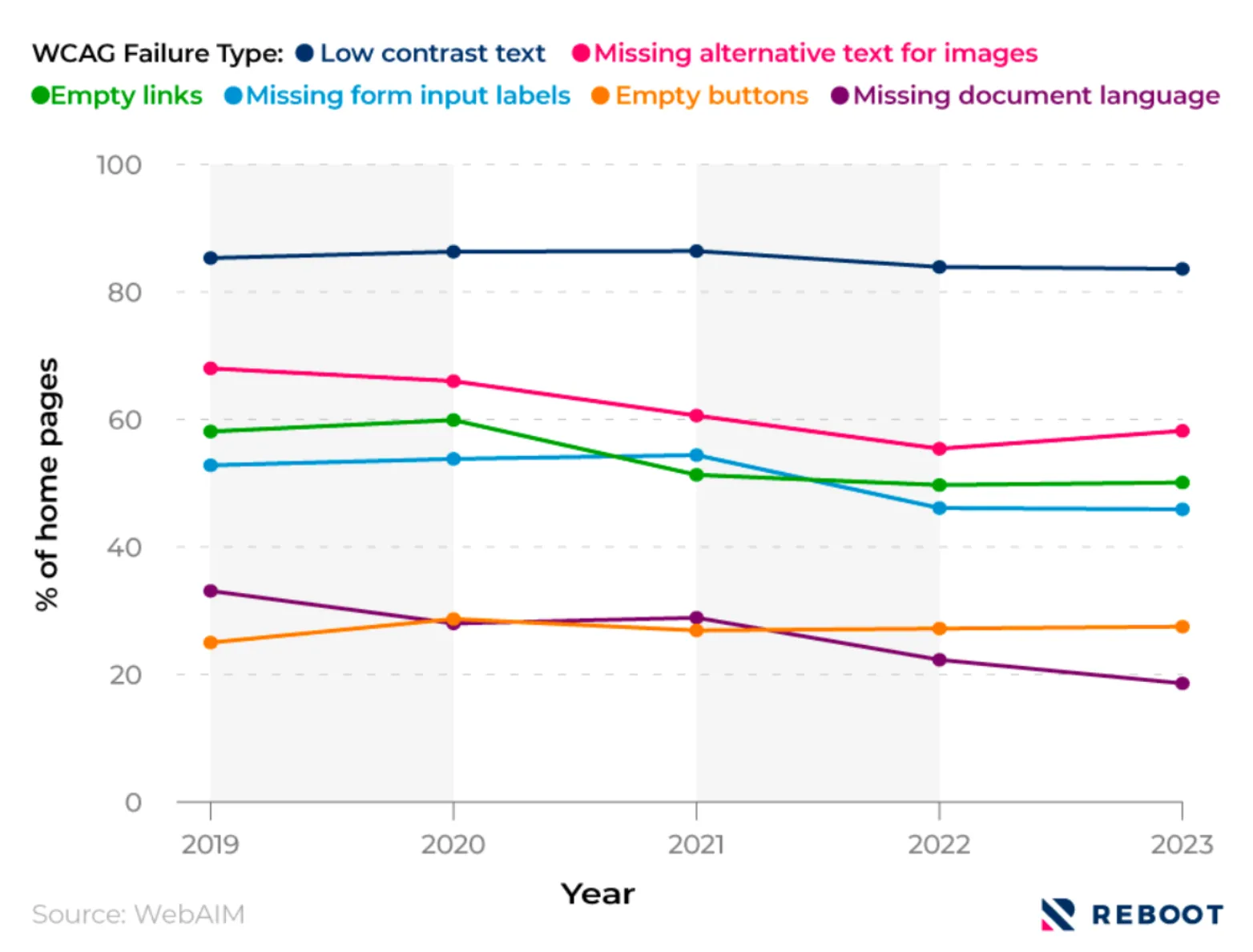
The most common type of WCAG failure detected on websites in 2023 was low-contrast text. This was the case for more than 4 in 5 websites (83.6%) analysed, yet represented a 1.7% drop from 2019 figures.
Generally speaking, the percentage of websites with WCAG errors has decreased since 2019.The proportion of websites with missing alt-text for images fell by almost 10% between 2019-23.
Yet, despite these improvements, almost 3 in 5 websites (58.2%) in 2023 still lack this important accessibility feature for those with visual impairments.
Missing document language was the least common WCAG-detected error across websites in 2023, with less than 1 in 5 (18.6%) reporting this failure — almost half the recorded figure for 2019 (33.1%).
Responsive web
design statistics
Web design statistics reveal that a responsive website design is not just about the aesthetics and visual appeal of a webpage.
A survey by WebsiteBuilder suggests that 3 in 5 users (60%) don’t return to a website if the page is unresponsive.
With an average attention span of just 8 seconds per internet user, web designers must create sites that respond quickly alongside being visually appealing and engaging.

Importantly, 85% of those surveyed demanded a high level of responsiveness on both mobile and desktop devices. This is supported by a study from Stayntouch, which found that 2 in 5 (40%) consumers will not wait more than 3 seconds for a page to load on a mobile, before returning to the SERP.

Website cost
statistics
What is the average cost of a website?
According to an analysis of the latest website cost statistics for 2024, the median average cost of a website is £15.90 per month, yet the mean average cost of a website stands at £68.25 per month.
To help ascertain the average cost for a website build, we collated website pricing statistics from various web-building tools and companies available online across a range of packages they were offering customers.
The average cost of a website build is a complex calculation, as companies offer a variety of packages, each with a different level of service, making them difficult to compare.
Website cost statistics across different companies and packages
website
| Package 1 (price per month) | Package 2 (price per month) | Package 3 (price per month) | Package 4 (price per month) | Package 5 (price per month) | Package 6 (price per month) | |
|---|---|---|---|---|---|---|
| Wix | £7.50 | £14 | £20 | £119 | - | - |
| WordPress | £0 | £3 | £7 | £20 | £36 | £1,631 |
| Squarespace | £12 | £17 | £23 | £35 | - | - |
| Jimdo | £0 | £9 | £15 | £20 | £39 | - |
| Webnode | £2.90 | £4.90 | £8.90 | £15.90 | - | - |
| Webflow | £0 | £14.10 | £22.72 | £38.39 | - | - |
| GoDaddy | £6.99 | £8.99 | £11.99 | £12.99 | - | - |
| Pixpa | £6.40 | £11.99 | £15.99 | £19.99 | - | - |
| Shopify | £25 | £65 | £344 | - | - | - |
| Weebly | £0 | £7.83 | £9.40 | £20.37 | - | - |
| Square Online | £0 | £20 | £64 | - | - | - |
| Bitrix | £36 | £74 | £149 | £299 | - | - |
(Sources: Reboot Online via pricing lists from various company websites)
The cost of a website build can vary from £0 per month up to £2,803 per month, depending on many factors, including the:
-
Amount you have/wish to spend
-
Size of your company
-
Level of expertise you require and number of web designers
-
Amount of autonomy you wish to retain over the website
-
Degree of involvement do you want from external sources
-
Level of site analytics you require
-
Total online storage space you need
-
Site features and applications you wish to be built into the site.

Some web-building companies, such as WordPress, Jimdo, Webflow, Weebly, and Square Online, allow you to use their services for free in a limited capacity. Yet, others may charge for this service, ranging from £2.90 per month at Webnode up to £36 per month for Bitrix.
Our analysis reveals that the most expensive website package available in 2024 is WordPress’ VIP suite, with prices starting at $25,000 (around £19,579) per year.
The web design service industry is labour-intensive, meaning businesses are more reliant on labour than capital. The highest costs for a web design company, as a percentage of revenue, tend to be wages (30.4%), followed by purchases (20.7%) as well as rent and utilities (1.8%).
What is the average time to build a website?
In total, the average time to build a website is somewhere between 10 and 14 weeks and will include a series of steps to do this successfully, including:
These timings are estimations and could vary depending on how complex your website is and the features you desire for the final product.
These timings are estimations and could vary depending on how complex your website is and the features you desire for the final product.

build a website
The time to build a website can be affected by
various factors, such as:
-
Whether it’s a single scrolling page or a series of pages
-
If you’re doing it yourself, working with a single developer, or hiring a dedicated team of people
-
The purpose of the website (i.e. providing information vs selling products and services)
-
Complexity of your sitemap and website’s layout
-
Type of content on your website (e.g. written, videos, audio, data visualisations)
-
Navigational tools to enhance the user experience (UX) — such as menus, “return to top” features, AI chatbots etc.
According to Orbitmedia, the average lifespan of a website is around 2 years and 7 months. Therefore, adequate time must be taken to plan the website before publishing to make sure it’s fit for purpose, meets the needs of your target audience, and is planned with longevity in mind.

Global CMS Market
Statistics
The use of content management systems (CMS) in website creation has risen dramatically since 2011 when just over three-quarters (76%) of all websites were hand-coded. By 2022, this figure had fallen by a third (33%).
As of 2023, over 76 million websites worldwide now use a CMS to create web pages and manage online content. This accounts for around 90% of the top 1 million websites based on web traffic, and more than two-thirds (68%) of all websites.
Global CMS market revenue statistics
Revenue from the CMS market is projected to reach $22.27 billion by 2024. With a CAGR of 5.22% between 2024-28, this could mean the CMS industry is worth $27.3 billion by 2028.
In terms of global comparisons, around half (50%) is expected to be generated from the U.S., accounting for the majority of global revenue at $11.25 billion.
The most common CMS systems in the world
As of 2024, WordPress was the most commonly used CMS, occupying around three-fifths (62.9%) of the total CMS market. This made it almost 10 times more popular than Shopify, the second most popular option (6%).
World’s most common CMS systems (2024)
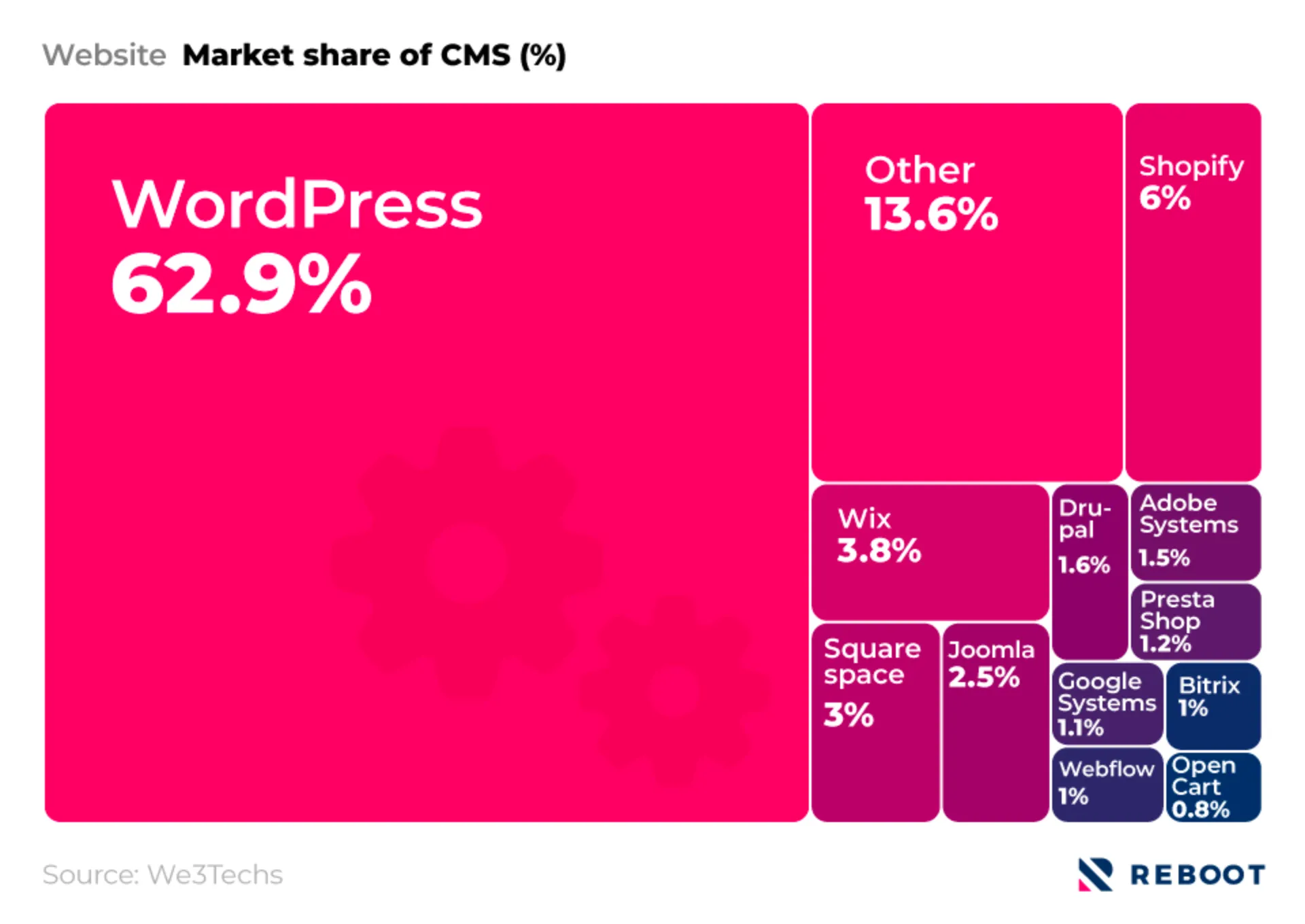
WordPress has consistently dominated the CMS market since 2013 when it accounted for just over half (54.8%) of all available CMS. By 2022, this figure had risen by more than 10%, occupying almost two-thirds (65.2%) of the overall market.
Most common CMS systems in the world over time
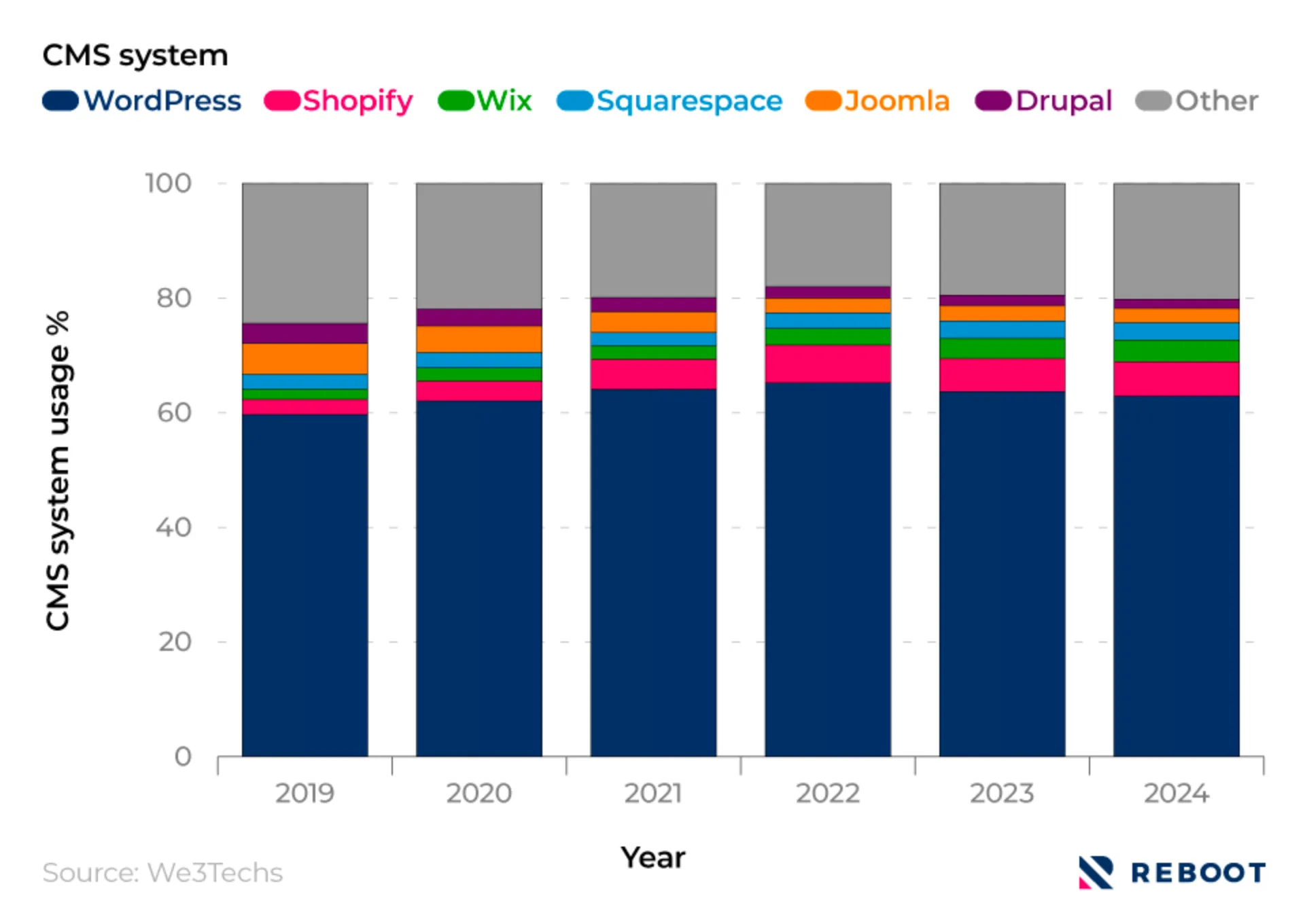
Back in 2014, Shopfiy had a market share of just 0.3%. Yet, by 2024 this had increased by a factor of 20 to become the second-most popular CMS behind WordPress. A similar story is seen for Wix, increasing from 0.2% to 3.8% in the same period.
Joomla and Drupal, on the other hand, experienced the opposite between 2014 and 2024, with both seeing a market share decrease of 6.8% and 3%, respectively.
Forecasted most common CMS systems between 2024-2030
| 2024 | 2026 | 2027 | 2028 | 2029 | 2030 | |
|---|---|---|---|---|---|---|
| WordPress | 65.24% | 65.98% | 67.71% | 70.26% | 73.08% | 76.53% |
| Shopify | 7.22% | 8.74% | 10.64% | 13.07% | 16.27% | 20.68% |
| Wix | 4.13% | 4.92% | 6.01% | 7.39% | 9.15% | 11.49% |
| Squarespace | 3.65% | 4.25% | 4.94% | 5.78% | 6.84% | 8.25% |
| Joomla | 1.27% | 0% | 0% | 0% | 0% | 0% |
| Drupal | 0.80% | 0.05% | 0% | 0% | 0% | 0% |
| Other | 17.69% | 16.41% | 13.85% | 10.29% | 6.34% | 1.18% |
(Source: Reboot Online via We3Techs)
Using forecast analysis, WordPress may continue to remain the most common CMS system for the foreseeable future, possibly obtaining a three-quarter market share (76.53%) by 2030.
Based on historical data, it’s estimated that Shopify could account for around a fifth (20.68%)
Based on historical data, it’s estimated that Shopify could account for around a fifth (20.68%) of the CMS market by 2030 — a roughly 13 percentage point increase from 2024.
of the CMS market by 2030 — a roughly 13 percentage point increase from 2024.
Conversely, based on current trends, Joomla and Drupal’s market share could reach 0% by 2026 and 2027, respectively.
CMS usage statistics over time
As of 2024, around 1 in 3 websites (32.3%) didn’t use a CMS — a figure that has halved since 2015, when the figure stood at almost two-thirds (64.8%).
WordPress usage statistics indicate that during this time, its popularity doubled, from just over a fifth (21%) to more than two-fifths (43.1%).
Between 2015 and 2024, the number of Shopify users increased by 3700%, from just 0.1% to 3.8%. A similar story is seen in the rising popularity of:
-
Wix (+2,300%)
-
Squarespace (+1,900%).
Conversely, CMS usage statistics for Joomla and Drupal almost halved in the 9 years before 2024, from 3.3% to 1.8% and 1.9% to 1.2%, respectively.
Forecasted CMS usage statistics between 2024-2030
| 2024 | 2026 | 2027 | 2028 | 2029 | 2030 | |
|---|---|---|---|---|---|---|
| None | 27.52% | 23.79% | 20.05% | 16.32% | 12.59% | 8.86% |
| WordPress | 46.55% | 49.19% | 51.83% | 54.46% | 57.10% | 59.74% |
| Shopify | 4.38% | 5.55% | 7.09% | 9.13% | 11.96% | 16.04% |
| Wix | 2.37% | 2.63% | 2.89% | 3.16% | 3.42% | 3.68% |
| Squarespace | 2.23% | 2.46% | 2.72% | 2.95% | 3.18% | 3.37% |
| Joomla | 1.69% | 1.16% | 0.47% | 0% | 0% | 0% |
| Drupal | 1.27% | 0.96% | 0.54% | 0% | 0% | 0% |
(Source: Reboot Online via We3Techs)
Our forecasted analysis suggests that WordPress will continue to assert its dominance in the world of CMS usage in the coming year, accounting for almost 3 in 5 websites (58.74%) by 2030. This represents an almost 13 percentage point increase in CMS usage statistics between 2024 and 2030.
The percentage of websites using Shopify is estimated to quadruple over this time, with respective
The percentage of websites using Shopify is estimated to quadruple over this time, with respective figures for Joomla and Drupal anticipated to reach 0% by 2028 (based on existing usage trends).
figures for Joomla and Drupal anticipated to reach 0% by 2028 (based on existing usage trends).
Incidentally, the proportion of websites not using a CMS is predicted to drop by around two-thirds between 2024-30. This could mean that by 2030, less than 1 in 10 (8.86%) websites will not use a CMS, compared to around 1 in 4 (27.52%) in 2024.
Business Website Statistics
Almost three-quarters (73%) of businesses claim to invest in web design, with nearly three-fifths (58%) opting to create a new website or improve their existing one.
Almost 9 in 10 web visitors (86%) expect a company’s homepage to explain its products and services, with half (50%) preferring the use of navigational menus to browse the site. Therefore, businesses need to tap into this and design websites that are helpful, user-friendly, and guide the visitor to the product, service, or information they require.

B2B website statistics
According to Sagefrog’s 2023 Marketing Mix report, more than a quarter (28%) of marketing companies claim that website development is their top area of spending when it comes to budget allocation.
The majority of marketing businesses (33%) will prioritise in-person tradeshows and events, followed by search engine marketing and optimisation (31%) and sales and marketing materials (30%).
Marketing spending statistics in terms of company priorities
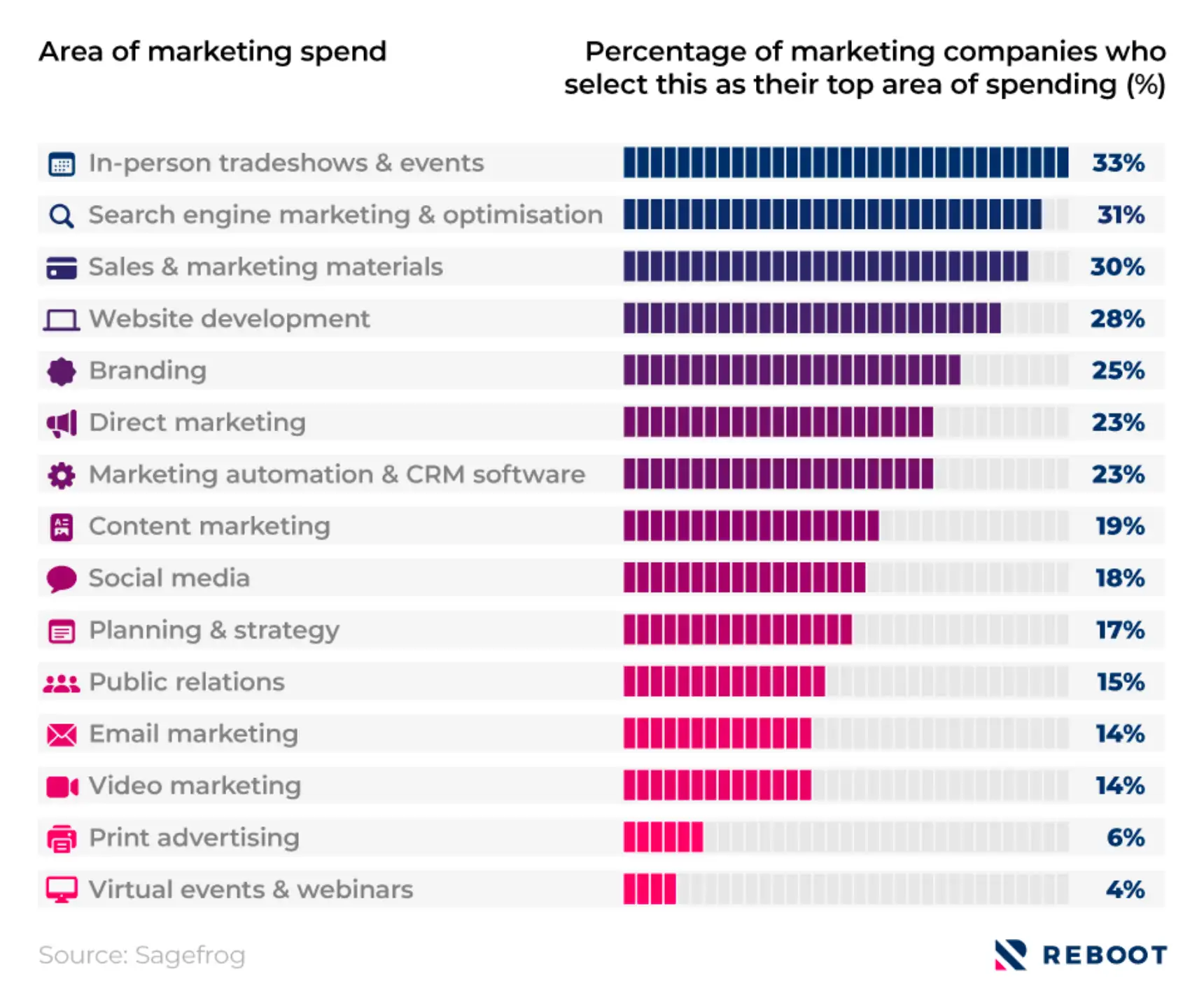
According to a Forbes Advisor survey, more than three-quarters (78%) of small business owners currently have a website in place for their business.
Small business website statistics and the importance of their website
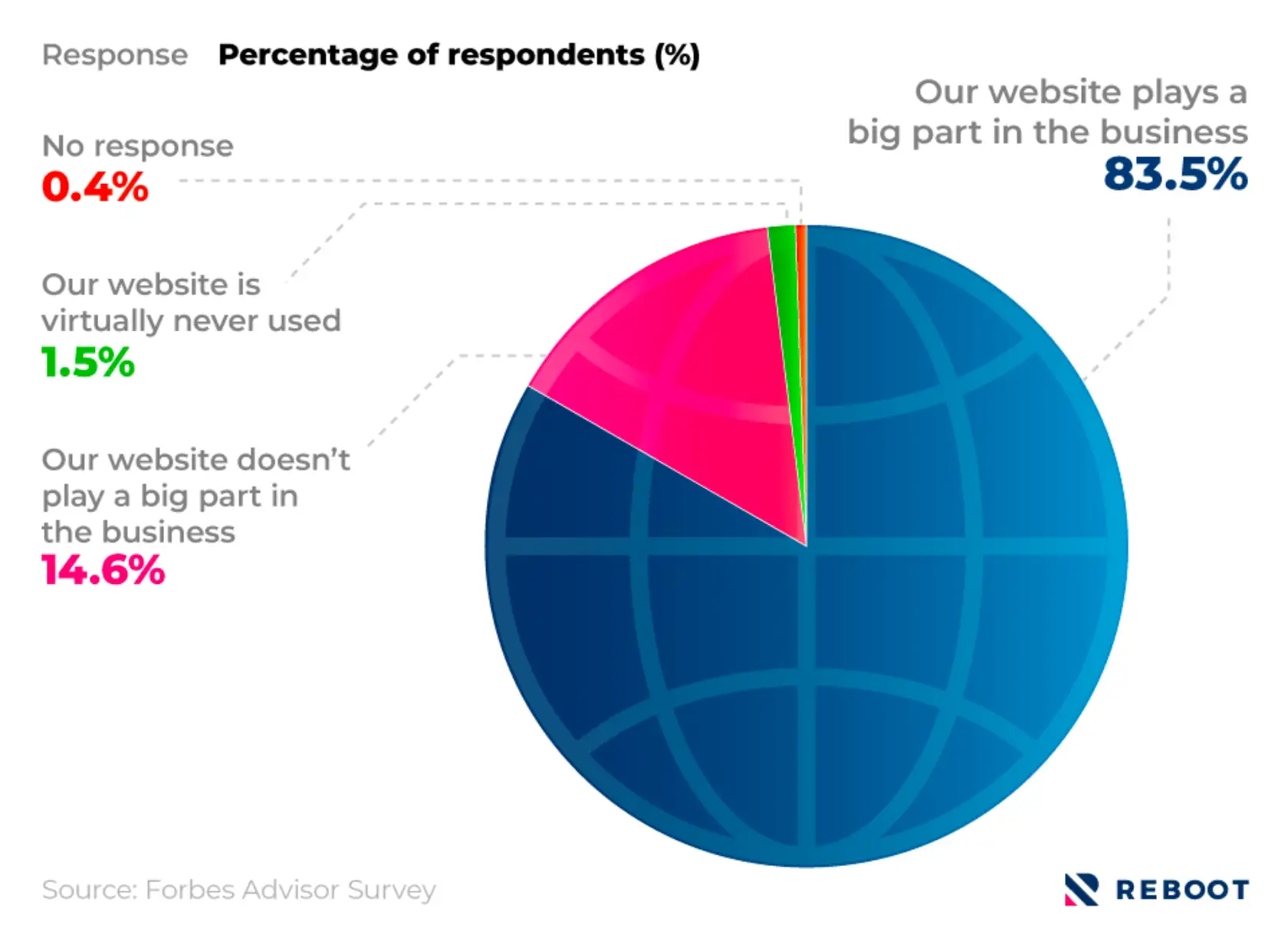
Of those small business owners with a website, the overwhelming majority (83.5%) admit that this plays a significant part in the business, with just under 15% stating the opposite.
Incidentally, just 1.5% of SME owners claim their website is never used.
Partnering up with an experienced ecommerce SEO agency could help drive meaningful business growth online and improve your ROI.
Contact us to find out how we can help benefit your business.
Small business website statistics and how SMEs update/maintain their website
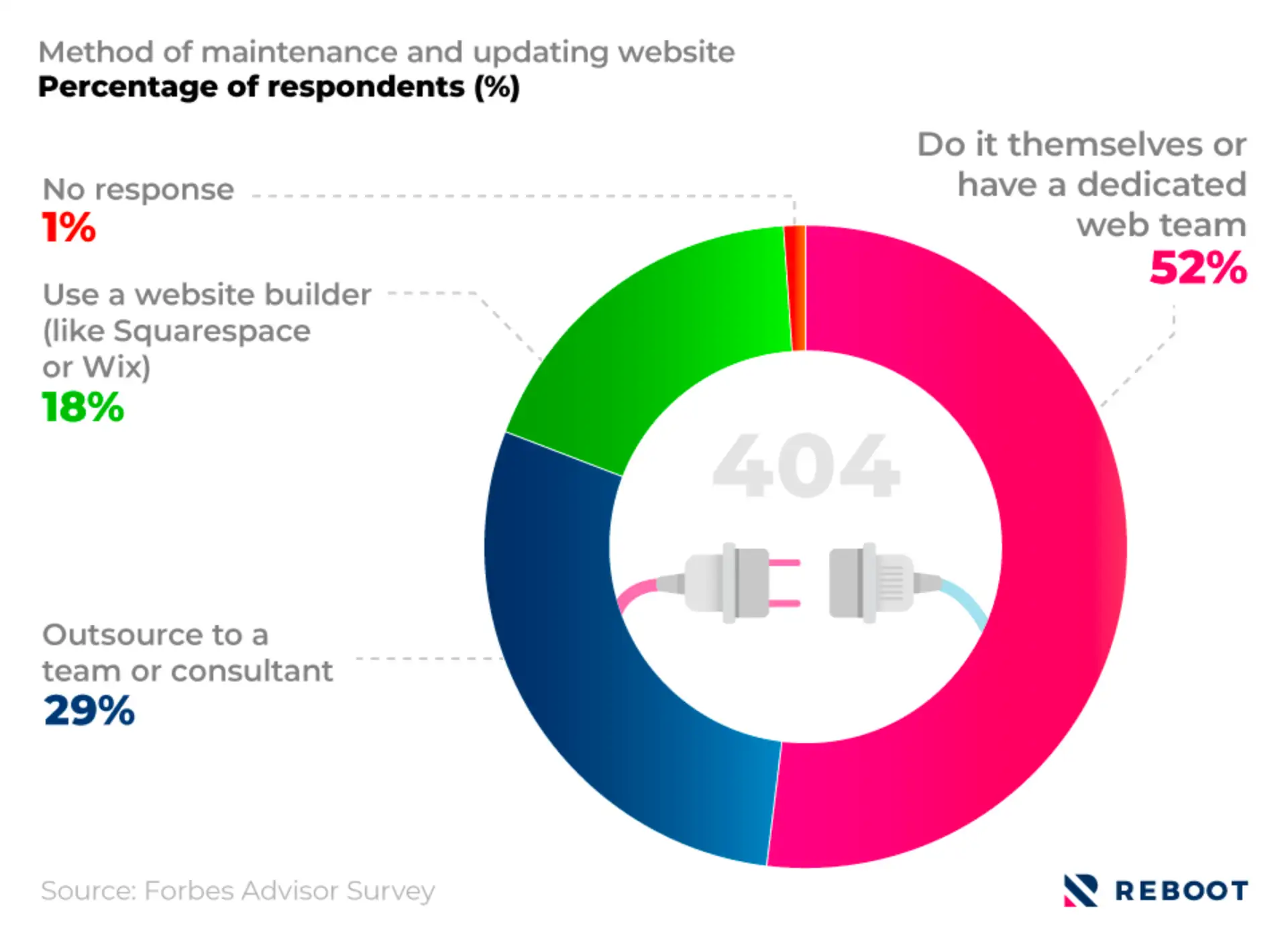
Just over half (52%) of SME owners with a website either maintain it themselves or have a dedicated web development team in-house, making it the most popular option among small businesses.
Around a third (29%) outsource their web development, with less than a fifth (18%) opting to use a website builder, such as Squarespace or Wix.
Small business website statistics and the most popular website builder services used by SMEs
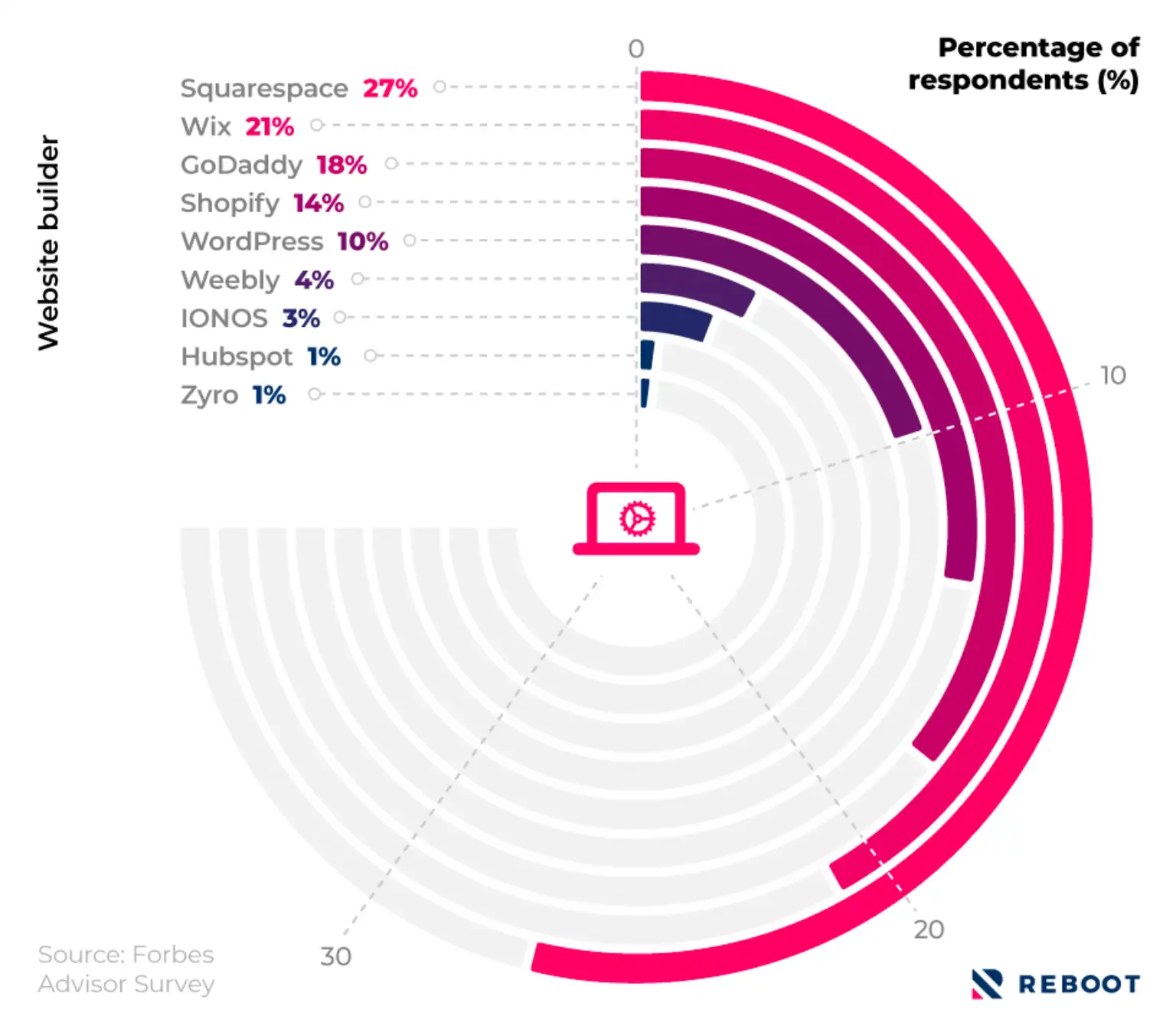
According to the Forbes Advisor survey, the majority of SMEs using a web builder service opt for Squarespace (27%), with just over a fifth (21%) turning to Wix.
Small business website statistics and whether SMEs without a website think they should haveone
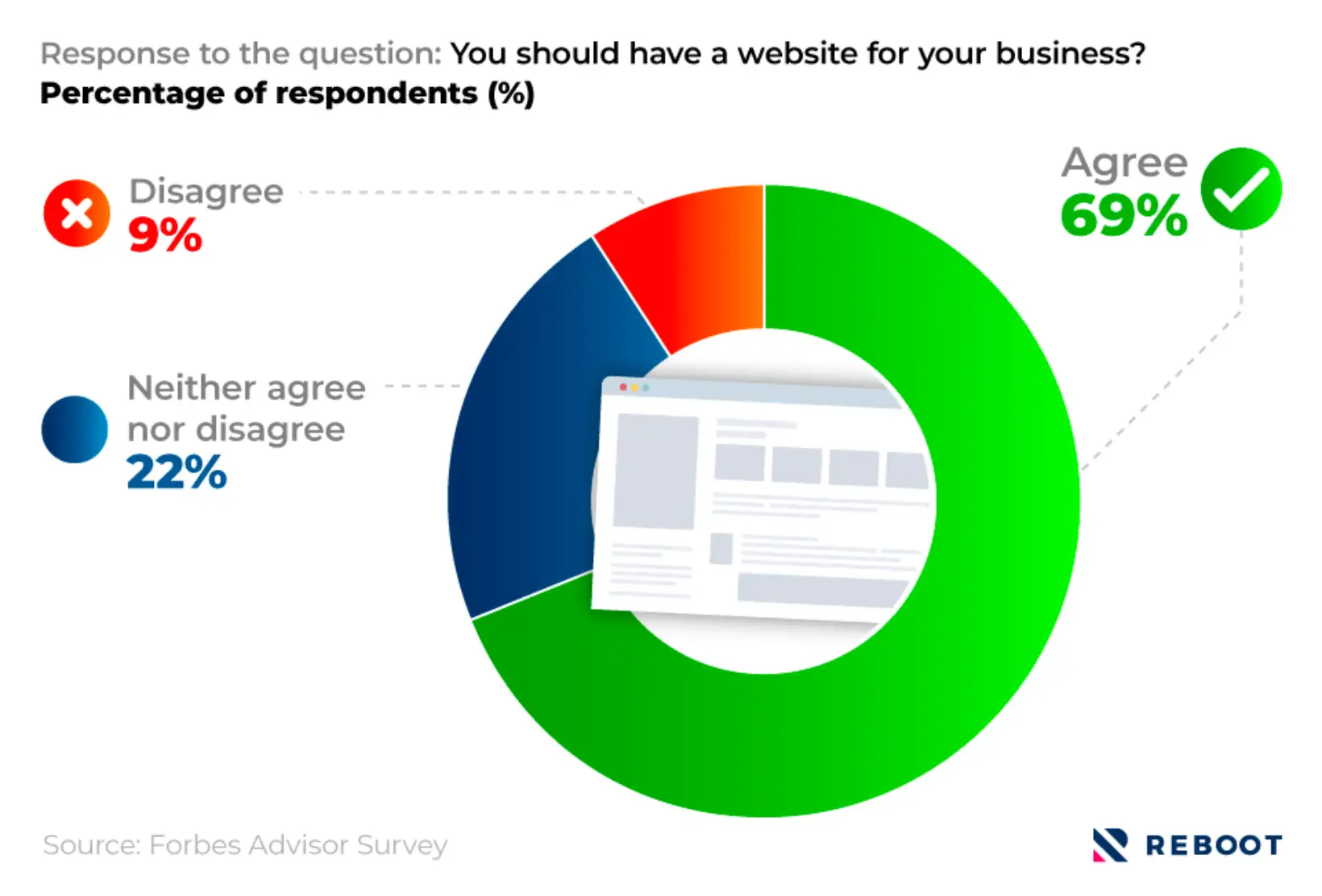
Nearly 7 in 10 (69%) SME owners without a website feel that their business should have one, compared to less than 1 in 10 (9%) who don’t believe they should.
Pairing up with a digital PR agency can help gain authoritative coverage and links from a wide variety of publications, helping you to bolster brand awareness and widen your reach amongst your target audience.
Global ecommerce website statistics
With in excess of 5 billion internet users worldwide, the number of people making online purchases is ever-increasing. According to some eCommerce SEO statistics, as of 2022, the global retail ecommerce market was valued at $5.7 trillion.
The number of digital buyers worldwide is believed to stand around 2.64 billion — or roughly 1 in 3 (33.5%) of the global population who engage with some form of online shopping.
Ecommerce sales accounted for nearly a fifth (19%) of global retail sales in 2022, with forecasts suggesting this figure could reach 25% by 2027.
Global ecommerce website statistics by total revenue
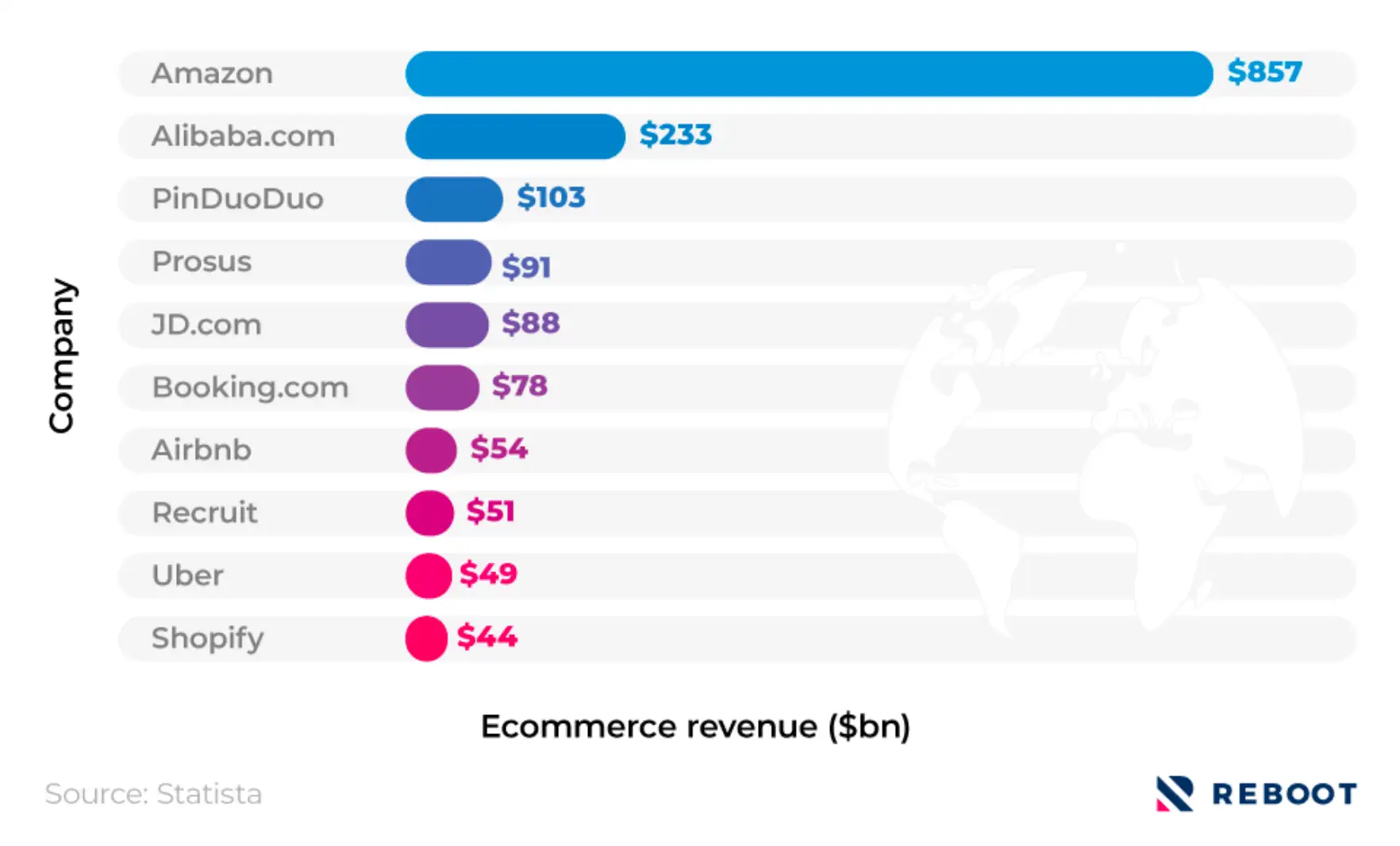
In terms of global website revenue statistics, Amazon is leading the way, with around $857 billion, as of 2022.
This is around 3 times more than Alibaba.com in second place, and 8 times more than PinDuoDuo in third.
Average value in online shopping orders globally by source (2023)
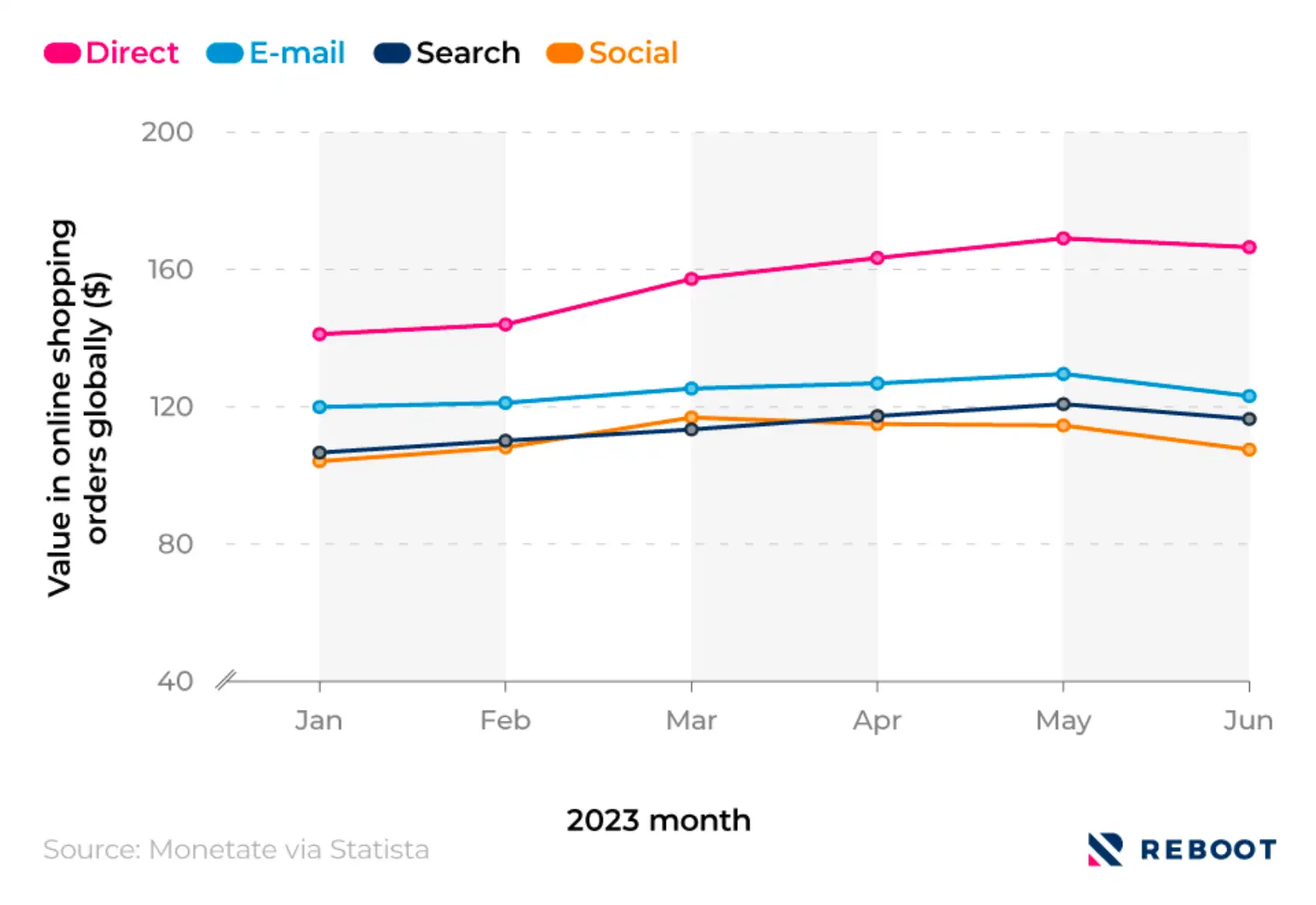
In 2023, the highest average value in online shopping globally came from direct navigation, reaching a peak of $169.08 per purchase in May.
By contrast, this was around $40 more than the average value of online shopping through email, and
By contrast, this was around $40 more than the average value of online shopping through email, and almost $50 more than a typical online purchase through search.
almost $50 more than a typical online purchase through search.
Social media typically had the lowest average online shopping value of 2023, fluctuating between $104.14 per purchase in January, up to $114.59 per purchase in May.
For more information, download our ecommerce whitepaper for the latest ecommerce trends and takeaways for 2024.
B2B ecommerce statistics
A study by VML evaluated the online search function of
23 B2B ecommerce websites and found that:
-
Over 60% of B2B websites had filters with options that narrowed the initial search results by up to 25%.
-
Almost three-quarters (74%) didn’t have product images
-
Just 4% had the option to “add to cart” or “add to favourites” while shopping
-
Just over half (56%) only returned results for exact match keyword searches
-
Around 90% of B2B customers look at 2-7 websites before making a purchase.
-
Almost 80% of B2B websites analysed didn’t offer a satisfactory zero-results experience
-
Around 2 in 5 (40%) of B2B websites cannot perform content searches.
Making simple changes to a B2B ecommerce website, such as adding product images, an “add to cart” option, and search functions that support synonyms, could go a long way to enhancing the user’s online shopping experience. This could increase the likelihood of consumers finding the product/service they desire, in turn boosting conversion rates.

Mobile usage in the B2B purchasing process is fast becoming commonplace. Around 4 in 5 B2B buyers (80%) claim to use their mobiles to research products, with 3 in 5 (60%) using a mobile to make a recent purchase.
On mobile websites, the search function is vitally important, as smaller screens make website browsing and navigation more difficult. However, VML’s research found that more than a quarter (27%) of B2B websites were underperforming in their mobile search experience.
For multinational B2B companies, the localisation feature is an important tool in helping the user select the language most appropriate to them. Yet, almost two-thirds (65%) of websites analysed by VML reported issues with the languages of their product data, with some listings failing to show due to a language mismatch.

For more information, check out our guide on the benefits of ecommerce SEO services and how they can help bolster web traffic to your site.
Global Website
Hosting Statistics
Global web hosting market
Revenue from the global web hosting market is expected to reach $157.9 billion by 2024.
With a projected CAGR of more than a fifth (+21.58%) between 2024-28, this means the market value could exceed $345 billion by 2028.
In terms of global comparisons, the majority of this revenue in 2024 (36.57%) is expected to be generated by the U.S. at $57.7 billion.
Global web hosting market share statistics
As of 2024, Wix.com has the largest market share of global web hosting. Accounting for less than half (46.09%) of all clients worldwide, this equates to around 110 million customers and around 5 times the amount of second-placed GoDaddy.com.
Global web hosting statistics by top 10 hosts, their market share, and approximate number of customers
| Hosting | Market share | Approximate number of customers |
|---|---|---|
| Wix.com | 46.09% | 110,000,000 |
| GoDaddy.com | 8.80% | 21,000,000 |
| Bravenet.com | 6.28% | 15,000,000 |
| Xinnet.com | 4.82% | 11,500,000 |
| HAW.company | 3.61% | 8,625,000 |
| Aruba.it | 1.97% | 4,700,000 |
| REG.RU | 1.55% | 3,700,000 |
| CNDNS.com | 1.26% | 3,000,000 |
| XServer.ne.jp | 1.01% | 2,400,000 |
| Namecheap.com | 0.84% | 2,000,000 |
(Source: Hostings.info)
Bravenet.com is the world’s third most popular web hosting company, as of 2024. With around 15 million customers, this represents about 6.28% of the total web hosting market.
Global Website
Security Statistics
Most common website security risks around the world
The number of reported global cyber attacks increased by around 125% between 2020 and 2021, with phishing remaining the most common form of cybercrime.
In 2021, 323,972 internet users reported being a victim of an online phishing attack, accounting for around 50% of all recorded cyber attacks for the year. In the same year, almost a billion emails were exposed, affecting around 1 in 5 (20%) of the global internet population.
According to website security statistics, around 85% of businesses around the world reported a bulk phishing attack in 2022 — 1% less than 2021 figures. This made bulk phishing the most commonly reported cybercrime of 2022.
In the same year, around three-quarters (76%) of businesses worldwide indicated they had fallen victim to a ransomware or smishing (SMS phishing) attack.
Spear phishing saw the biggest decrease in the number of reported cases between 2021 and 2022 (-5%), with vishing one of the few crimes to record an increase in cases (+2%) in the same period.
Global website security statistics by type of attack between 2021 and 2022
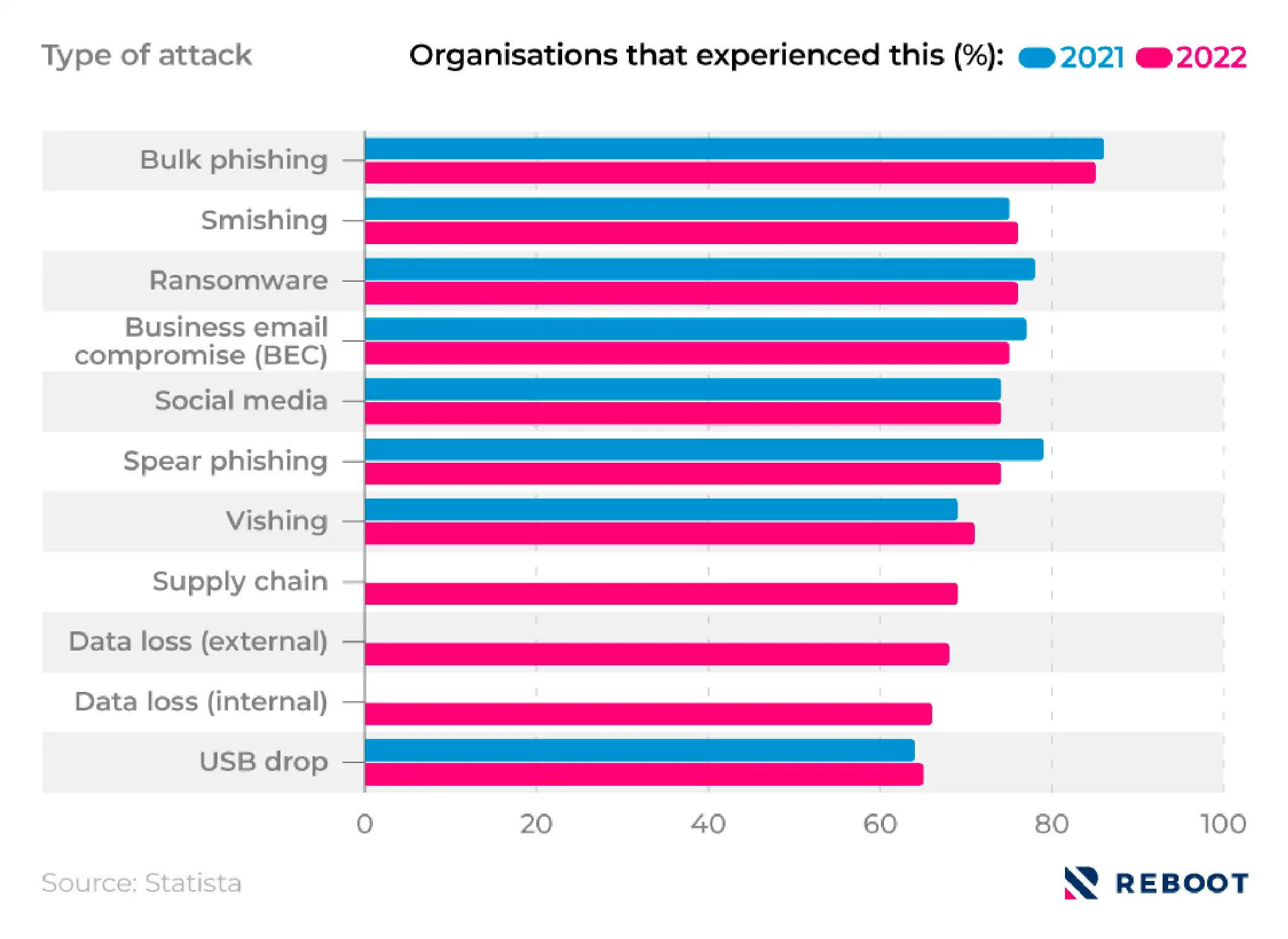
Public attitudes towards website security
According to a 2023 Statista survey, almost 2 in 5 (37%) internet users are worried about how companies might use their online data, with 41% opting to decline website cookies.
Conversely, less than 1 in 3 (30%) are comfortable with apps tracking their real-world activity.
Public attitudes towards the tracking of personal data
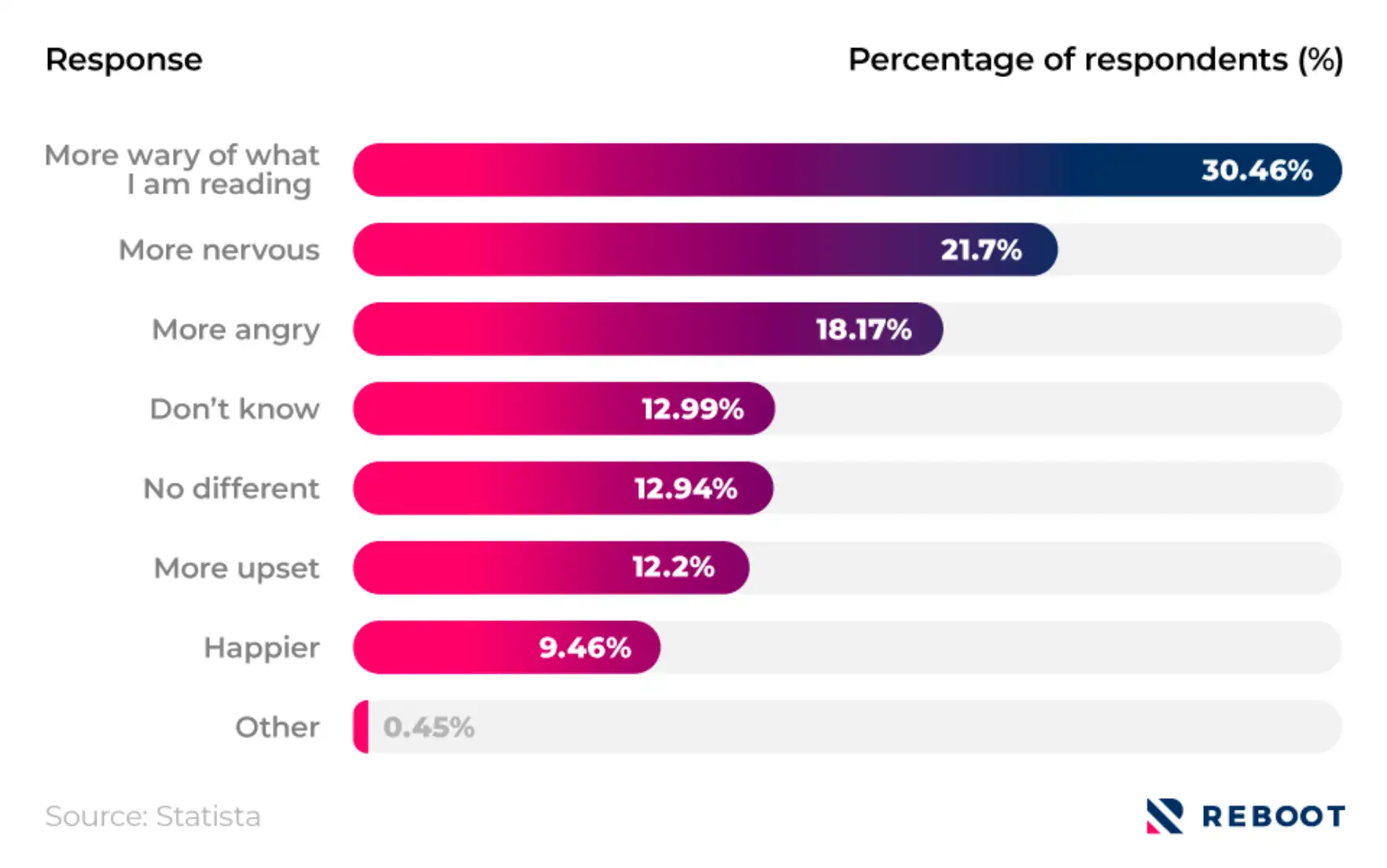
Website statistics reveal that around a third (30.46%) of adults feel more wary of what they are reading when it comes to websites tracking their data.
More than a fifth (21.7%) of people admit to being more nervous, with almost 1 in 10 (9.46%) feeling happier knowing their data is being tracked on websites.
Public opinions regarding personal information and online services
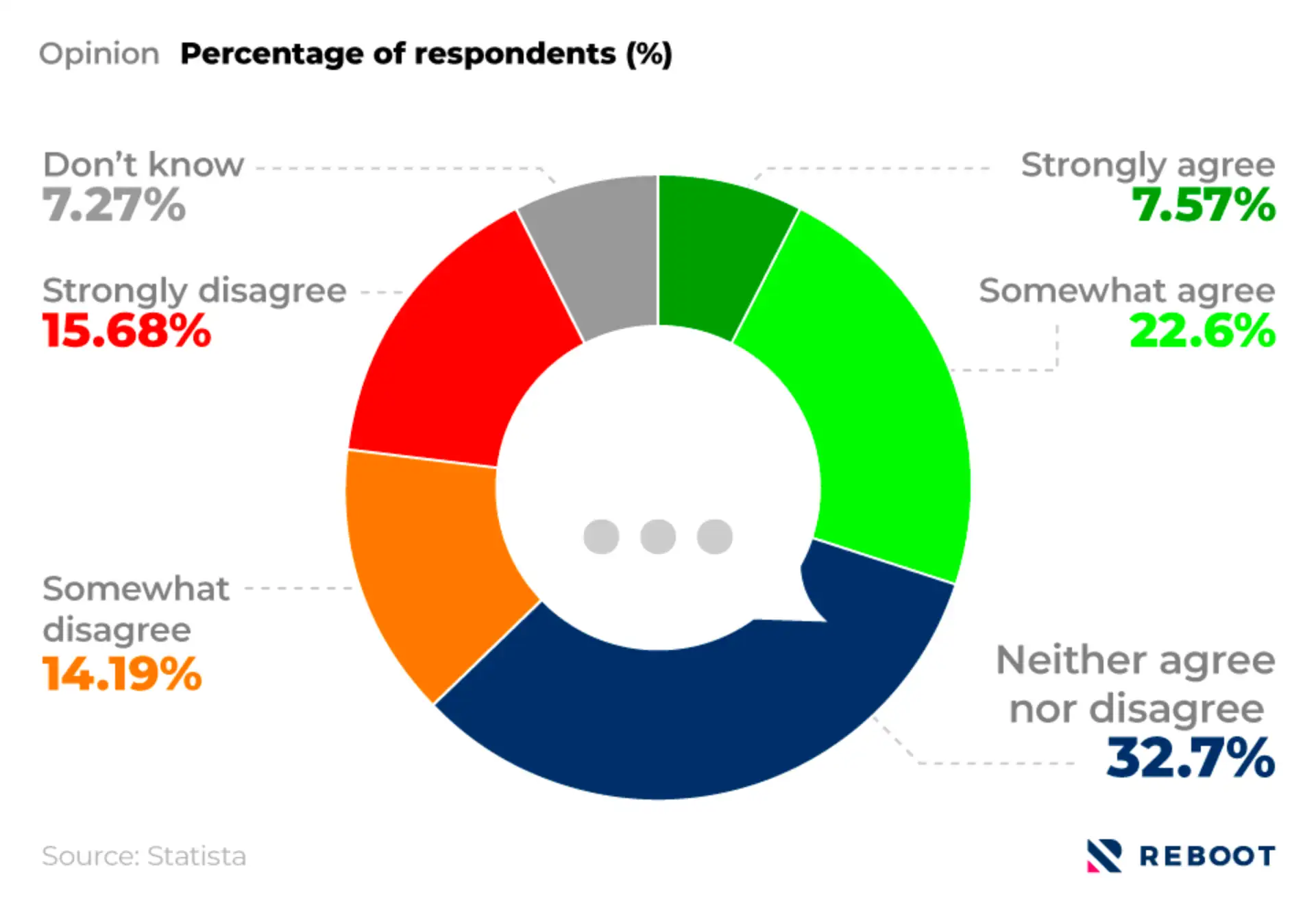
When it comes to providing personal information in return for online services, a 2023 Statista survey found that there is very little difference in public opinions.
Almost a third (30.17%) of adults agreed that giving away personal information in exchange for online services is acceptable. A similar percentage (29.87%) disagree with this, and nearly 1 in 3 people (32.7%) neither agree nor disagree.
Public opinion on website trust signals
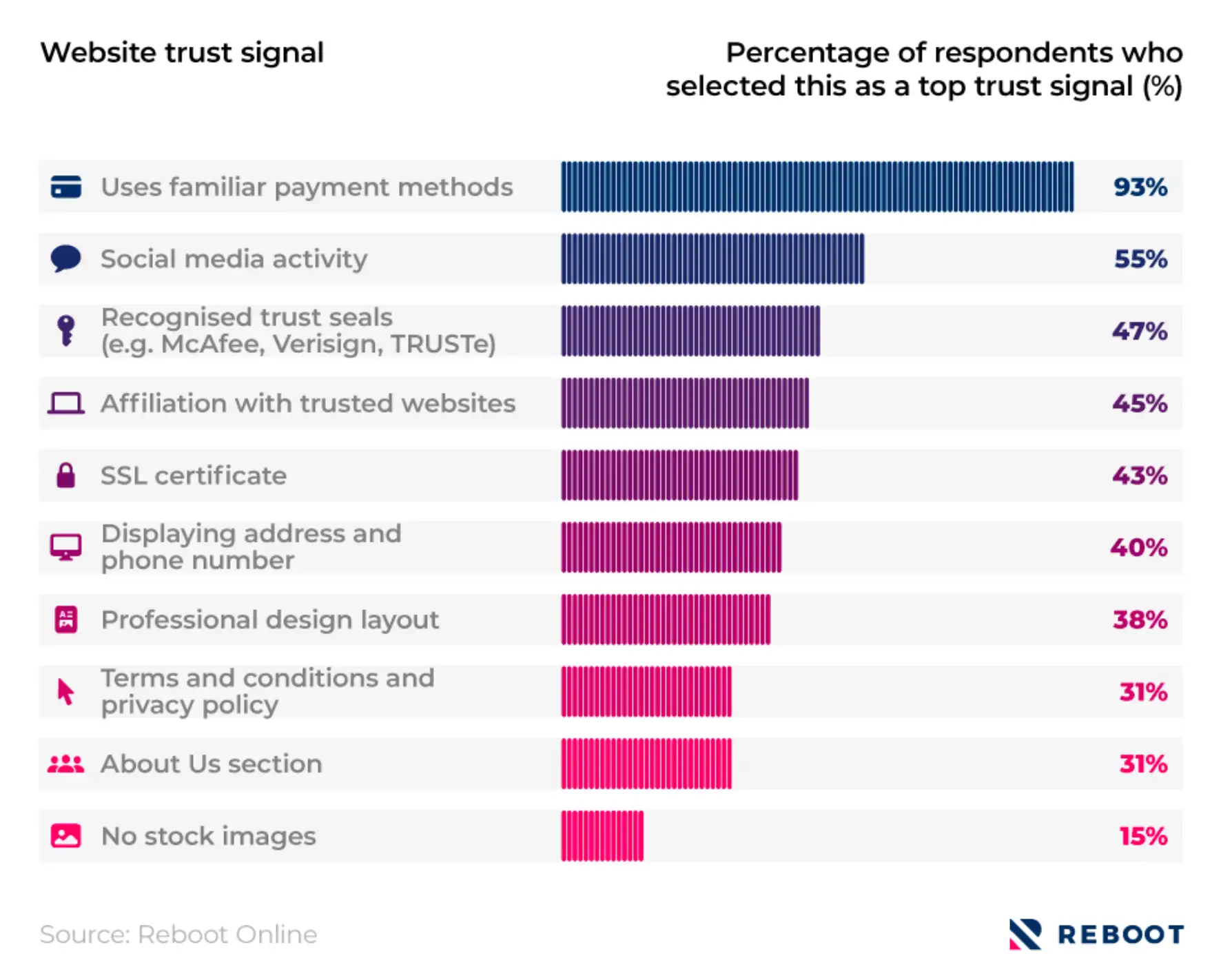
SEO agency Reboot Online surveyed 1,322 internet users to reveal the 10 most effective website signals that help rankings.
Around 9 in 10 people (93%) placed familiar payment methods as their most important trust signal for a website. This was followed by more than half (55%) who deemed social media activity as a significant website trust signal, with 45% claiming they would not use a website that wasn’t active on Twitter, Facebook, or Instagram.
For more information, check out our guide on the importance of social media for business, to see how a dedicated social media strategy can benefit your company and drive traffic to your website.
Website
Statistics FAQs

How to increase website traffic?
Many things can be done to increase website traffic, such as:
- Create high-quality, engaging contentthat is optimised for specific keywords across targeted landing pages
- Obtain backlinks from trustworthy sources
- Engage with your target audience, influencers, and community on social media to increase your brand visibility
- Optimise your page for a range of SEO services, including local searches
- Include testimonials on your website from satisfied customers
- Send out emails (e.g. newsletters and promotions) that link back to your website
- Use paid digital ads on social media to promote your site, either yourself or enlisting the services of a digital PR company .
How much traffic does a website get?
Website tracking tools like Semrush, Ahrefs, and SimilarWeb will only ever estimate how much traffic a website gets. While they will not provide you with exact figures, these web tracking tools will help indicate how many people are visiting your website, allow you to compare this with your competitors, and see what keywords you’re both ranking for.
What is website traffic?
Website traffic refers to the number of visits to a website from a browser, user, or searcher.
Can you make money from website traffic?
Yes! Websites can earn ad revenue based on the number of monthly page views and visits. By placing relevant adverts on your site, you can also earn money from each click or sale. You can also use affiliate marketing to promote products or services from other companies, which can generate additional sources of income, or become a host for sponsored content on your site.
Does website traffic increase Google's ranking?
Website traffic is a key indicator for your Google ranking. An increase in direct and organic traffic to your website shows Google that your domain has high authority, popularity and relevance. As a result, your site will tend to rank higher on the search engine results page (SERP). However, web traffic alone does not directly increase your Google ranking.
Sources and Methodology
Topic: Internet usage worldwide (no date) Statista. Available at: https://www.statista.com/topics/1145/internet-usage-worldwide/ (Accessed: February 21, 2024).
NJ (2023) How many websites are there in the world?, Siteefy. Available at: https://siteefy.com/how-many-websites-are-there/ (Accessed: February 21, 2024)
Most visited websites in the United Kingdom 2024 (no date) Semrush. Available at: https://www.semrush.com/trending-websites/gb/all (Accessed: February 21, 2024).
Search engine market share worldwide (no date) StatCounter Global Stats. Available at: https://gs.statcounter.com/search-engine-market-share (Accessed: February 21, 2024).
Dharmadhikari, S. and Cognitive Market Research (2023) Web Design Services market size was USD 58.5 billion in 2022!, Cognitive Market Research. Available at: https://www.cognitivemarketresearch.com/web-design-services-market-report (Accessed: February 21, 2024).
Radić, D. (2022) Web design statistics 2024: Market, UX, SEO, and more, Serpwatch.io. SerpWatch. Available at: https://serpwatch.io/blog/web-design-statistics/ (Accessed: February 21, 2024).
Sunico, J. (2022) 30 astonishing website design industry statistics for 2023, Websitebuilder.org. Available at: https://websitebuilder.org/blog/website-design-industry-statistics/ (Accessed: February 21, 2024).
Lindgaard, G. et al. (2006) “Attention web designers: You have 50 milliseconds to make a good first impression!,” Behaviour & information technology, 25(2), pp. 115–126. doi: 10.1080/01449290500330448.
(No date) Researchgate.net. Available at: https://www.researchgate.net/publication/221516871_Trust_and_mistrust_of_online_health_sites (Accessed: February 21, 2024).
WebAIM: The WebAIM Million - The 2023 report on the accessibility of the top 1,000,000 home pages (no date) Webaim.org. Available at: https://webaim.org/projects/million/ (Accessed: February 21, 2024).
ACHIEVING DELICIOUSNESS: The state of content (no date) Adobe.com. Available at: https://landing.adobe.com/en/na/products/creative-cloud/264699-state-of-content/index.html (Accessed: February 21, 2024).
Golla, F. (2017) 40% of consumers will leave a hotel website if it’s not mobile friendly, Stayntouch. Available at: https://www.stayntouch.com/blog/40-of-consumers-will-leave-hotel-website-if-its-not-mobile-friendly/ (Accessed: February 21, 2024).
Wix Pricing Information (no date) Wix Pricing Information | Upgrade to a Premium Plan | Wix.com. Available at: https://www.wix.com/premium-purchase-plan/dynamo (Accessed: February 21, 2024).
Wordpress.com pricing and plans (2016) Wordpress.com. Available at: https://wordpress.com/pricing/ (Accessed: February 21, 2024).
Squarespace pricing - all pricing plans – (no date) Squarespace. Available at: https://www.squarespace.com/pricing (Accessed: February 21, 2024).
Jimdo (no date) Jimdo. Available at: https://www.jimdo.com/pricing/website/ (Accessed: February 21, 2024).
Webnode AG [webnode.com] (no date) Webnode website pricing, Webnode Website Pricing | Premium Plans. Available at: https://www.webnode.com/pricing-w2/ (Accessed: February 21, 2024).
Plans & pricing (no date) Webflow.com. Available at: https://webflow.com/pricing (Accessed: February 21, 2024).
(No date b) Godaddy.com. Available at: https://www.godaddy.com/en-uk/websites/website-builder/plans-and-pricing (Accessed: February 21, 2024).
Pixpa - all-inclusive, affordable pricing plans (no date) Pixpa - All-inclusive, Affordable Pricing Plans. Available at: https://www.pixpa.com/pricing (Accessed: February 21, 2024).
Shopify pricing - setup and open your online store today – free trial (no date) Shopify. Available at: https://www.shopify.com/uk/pricing (Accessed: February 21, 2024).
Pricing (no date) Weebly.com. Available at: https://www.weebly.com/uk/pricing (Accessed: February 21, 2024).
Square Online Plans, free eCommerce for real businesses (no date) Square. Available at: https://squareup.com/gb/en/online-store/plans (Accessed: February 21, 2024).
In, L. (no date) Pricing, Bitrix24.uk. Available at: https://www.bitrix24.uk/prices/ (Accessed: February 21, 2024).
Web Design Services in the UK - number of businesses (no date) Ibisworld.com. Available at: https://www.ibisworld.com/united-kingdom/number-of-businesses/web-design-services/14606/ (Accessed: February 21, 2024).
Content Management Software - global (no date) Statista. Available at: https://www.statista.com/outlook/tmo/software/enterprise-software/content-management-software/worldwide (Accessed: February 21, 2024).
Balkhi, S. (2022) 2024’s CMS market share report - latest trends and usage stats, WPBeginner. Available at: https://www.wpbeginner.com/research/cms-market-share-report-latest-trends-and-usage-stats/ (Accessed: February 21, 2024).
Matthews-El, T. (2023) How long does it take to build A website?, Forbes. Available at: https://www.forbes.com/advisor/business/software/how-long-build-website/ (Accessed: February 21, 2024).
(No date c) Orbitmedia.com. Available at: https://www.orbitmedia.com/blog/website-lifespan-and-you/ (Accessed: February 21, 2024).
Market share trends for content management systems (no date) W3techs.com. Available at: https://w3techs.com/technologies/history_overview/content_management (Accessed: February 21, 2024).
(No date d) Amazonaws.com. Available at: https://sagefrog-website.s3.amazonaws.com/2022/11/Marketing-Mix-2023-Report.pdf (Accessed: February 21, 2024).
Pratt, K. (2023) UK website statistics 2024, Forbes. Available at: https://www.forbes.com/uk/advisor/business/software/website-statistics/ (Accessed: February 21, 2024).
E-commerce worldwide - statistics & facts (no date) Statista. Available at: https://www.statista.com/topics/871/online-shopping (Accessed: February 21, 2024).
Cramer-Flood, E. (2022) Global Ecommerce Forecast & Growth Projections, Insider Intelligence. Available at: https://www.insiderintelligence.com/content/global-ecommerce-forecast-2022 (Accessed: February 21, 2024).
Lewis, R. (2023) Retail sales, Great Britain - Office for National Statistics, Gov.uk. Office for National Statistics. Available at: https://www.ons.gov.uk/businessindustryandtrade/retailindustry/bulletins/retailsales/november2023 (Accessed: February 21, 2024).
Global e-commerce share of retail sales 2027 (no date) Statista. Available at: https://www.statista.com/statistics/534123/e-commerce-share-of-retail-sales-worldwide/ (Accessed: February 21, 2024).
Market cap value of top consumer internet index companies 2023 (no date) Statista. Available at: https://www.statista.com/statistics/208843/stock-market-value-of-web-based-companies/ (Accessed: February 21, 2024).
Monthly global online shopping order value 2023, by traffic source (no date) Statista. Available at: https://www.statista.com/statistics/325384/online-shopping-order-values-traffic-source/ (Accessed: February 21, 2024).
U.S. average online shopping order value 2020-2022, by device (no date) Statista. Available at: https://www.statista.com/statistics/439516/us-online-shopping-order-values-by-device/ (Accessed: February 21, 2024).
The state of B2B site search (no date) VML. Available at: https://www.vml.com/insight/the-state-of-b2b-site-search (Accessed: February 21, 2024).
Web Hosting - worldwide (no date) Statista. Available at: https://www.statista.com/outlook/tmo/it-services/it-outsourcing/web-hosting/worldwide (Accessed: February 21, 2024).
(No date e) Hostings.info. Available at: https://hostings.info/hostings/market_share/ (Accessed: February 21, 2024).
Imber, D. (2024) “The Latest Cyber Crime Statistics (updated February 2024),” AAG IT Services. AAG, 1 February. Available at: https://aag-it.com/the-latest-cyber-crime-statistics/ (Accessed: February 21, 2024).
Cyber crime & security (no date) Statista. Available at: https://www.statista.com/markets/424/topic/1065/cyber-crime-security/ (Accessed: February 21, 2024).
NCSI :: Ranking (no date) Ega.ee. Available at: https://ncsi.ega.ee/ncsi-index/?order=rank (Accessed: February 21, 2024)
Attitudes on personal data tracking UK 2023 (no date) Statista. Available at: https://www.statista.com/statistics/1385066/uk-personal-data-tracking-attitudes/ (Accessed: February 21, 2024).
UK: attitudes of internet users regarding online privacy Q3 2022 (no date) Statista. Available at: https://www.statista.com/statistics/1386118/online-adults-attitudes-data-privacy-uk/ (Accessed: February 21, 2024).
Attitudes on personal data tracking UK 2023 (no date) Statista. Available at: https://www.statista.com/statistics/1385066/uk-personal-data-tracking-attitudes/ (Accessed: February 21, 2024).
- The top 100 most visited website in Dec 2023 (as reported by SEMrush) were analysed for a variety of performance metrics from Jan 2023 to Dec 2023 using SEMrush traffic analysis.
- For each domain, the number of visits, unique visitors, pages/visit, average visit duration and bounce rate were obtained for every month, as were the yearly averages for each of the 100 domains.
- Note: 'microsoftonline.com', 'imdb.com', and 'fsbx.com' could not be analysed by Google Lighthouse and returned loading errors.
- For the forecasted data - a linear regression model was fitted to the historical data to forecast future values up to 2030. The model assumes the metrics continue to change at the rate they have over the period analysed.
Top websites in the World - top rankings January 2024 (2024) Semrush. Available at: https://www.semrush.com/website/top/global/all/ (Accessed: February 21, 2024)
Speed index (2019) Chrome for Developers. Available at: https://developer.chrome.com/docs/lighthouse/performance/speed-index (Accessed: February 21, 2024)
